Enterprise websites can be defined by the size of the company or website, the complexity of the technology or teams, or by global operations. Some examples of enterprise websites would include many publicly traded companies, large ecommerce websites, businesses with many locations, or businesses with many websites. For example, we see 275 million ranking pages on amazon.com giving them 686 million estimated visits from organic search each month, or microsoft.com has an estimated 516 million organic visits per month.
Enterprise SEO differs from the SEO you may be used to in a few ways including scale, complexity, and competition level. Enterprise sites are some of the largest and most complex sites on the internet, and the scale and complexity of the sites and the teams needed to run the site create some unique challenges. The competition is fierce with a lot of money on the line, and enterprise sites will be going after some of the most competitive head term keywords that exist, while smaller companies may be targeting more long-tail searches.
How do you know if your company counts as an enterprise? I like to joke that you know it’s enterprise when everyone speaks a new language made almost entirely of three-letter acronyms (“Did the SEO SME review the PLP?”), and there are teams of people for everything.
If that sounds like the environment you’re working in, keep reading as I’m going to share insights from my previous experience (four years working in-house for IBM, and many years working for other enterprises from the agency and consulting side) that may help you.
There are many reasons enterprise companies should focus on SEO. These include:
- Credibility. With every new touchpoint you have the opportunity to be seen as the expert and dominant offering. This helps with the perception of your brand and makes your product an easier choice.
- Growth. SEO brings you increased visibility and brand awareness.
- Revenue. Every touchpoint is a chance at a conversion or sale. You’ll increase customer lifetime value and reduce customer acquisition costs.
- Supports other marketing channels. For instance, you can use paid advertising to retarget an audience based on the content they consumed on your website.
Making your content marketing successful takes a lot of work. Here are some of the things you can do as part of your enterprise content marketing strategy.
Create new content
There are many different types of content you can create, but with limited resources, it’s usually best to start out with informational content and videos since they provide high ROI. After you’ve got more resources, you can create things like virtual events, courses, e-books, case studies, white papers, podcasts, or even magazines or books.
The sales process for enterprise companies is typically longer. Many companies want to skip top-of-the-funnel and informational content and focus more on the end-of-funnel traffic that converts. In doing so, they narrow their pipeline and give their competitors opportunities to be seen as experts instead of them.
Starting with bottom-of-the-funnel content makes sense, but eventually, you’ll want to create that top-of-the-funnel content and expand your pipeline.
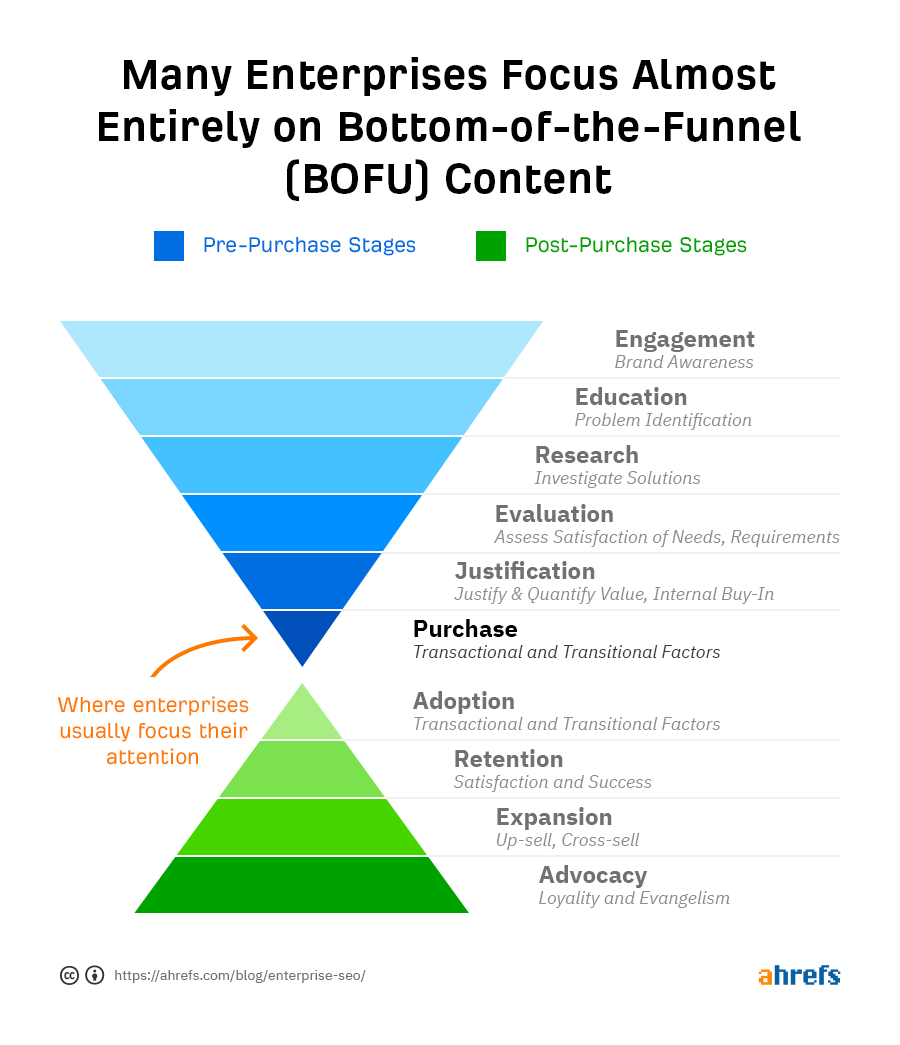
When creating content, you have to find a process that works best for your company and content creators. That will change depending on who is creating your content.
What content should you create?
I like to start with my competitor’s top pages rather than starting research with a list of keywords. If you export and combine this data, you end up with a list of your competitor’s most successful content, and you can start with the content you know already works and is likely driving value to a competitor. I talk about my process for this in our article on how to create great content.
Every team I ever worked with, whether product-focused or marketing-focused, loved to see this data. You may want to keep track of your content creation in Google Sheets or Airtable.
Alternatively, you can use the Content Gap tool to find these opportunities, but you may see some repeated opportunities because of similar keywords. We will update this to add clustering and help reduce this extra noise.
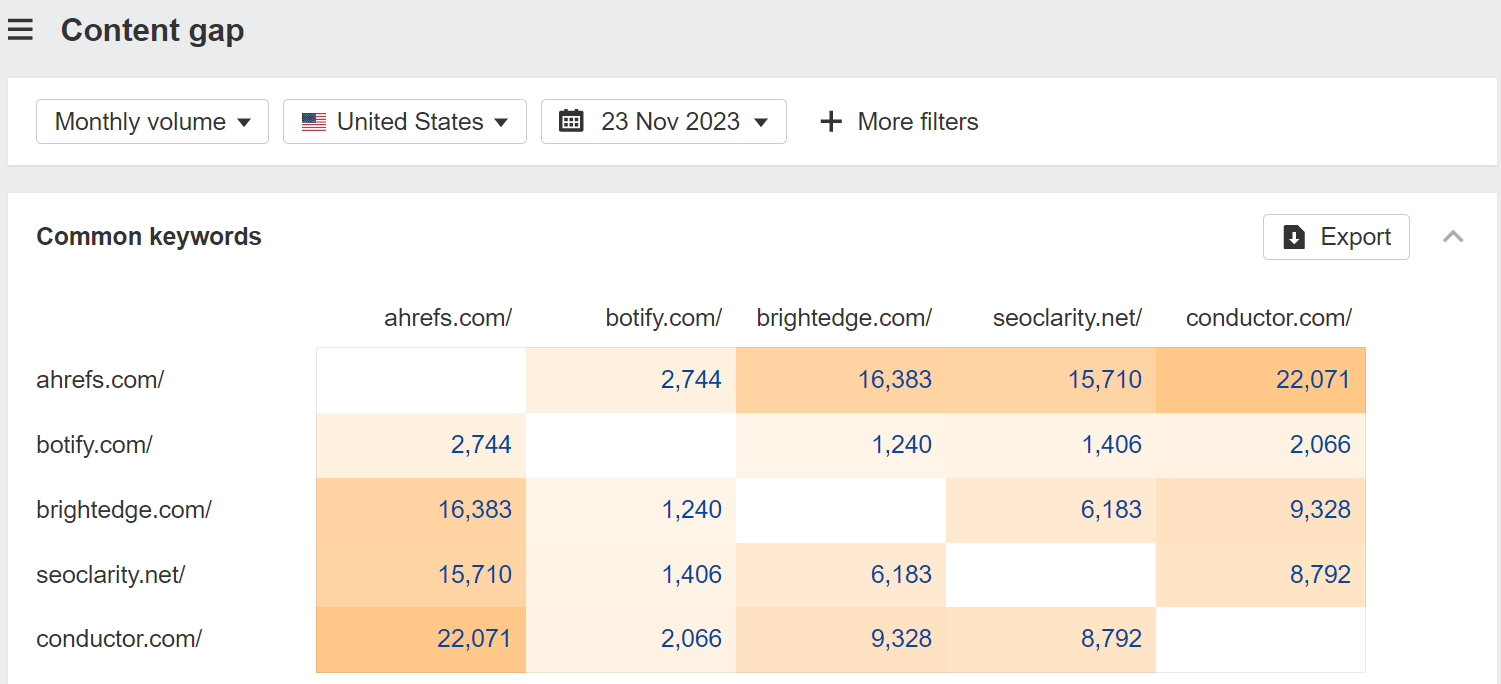
For now, you may want to export the keywords from the Content Gap tool, paste them into Keywords Explorer, and go to the “Clusters by Parent Topic” tab. This should give you actual content opportunities you may not be covering.
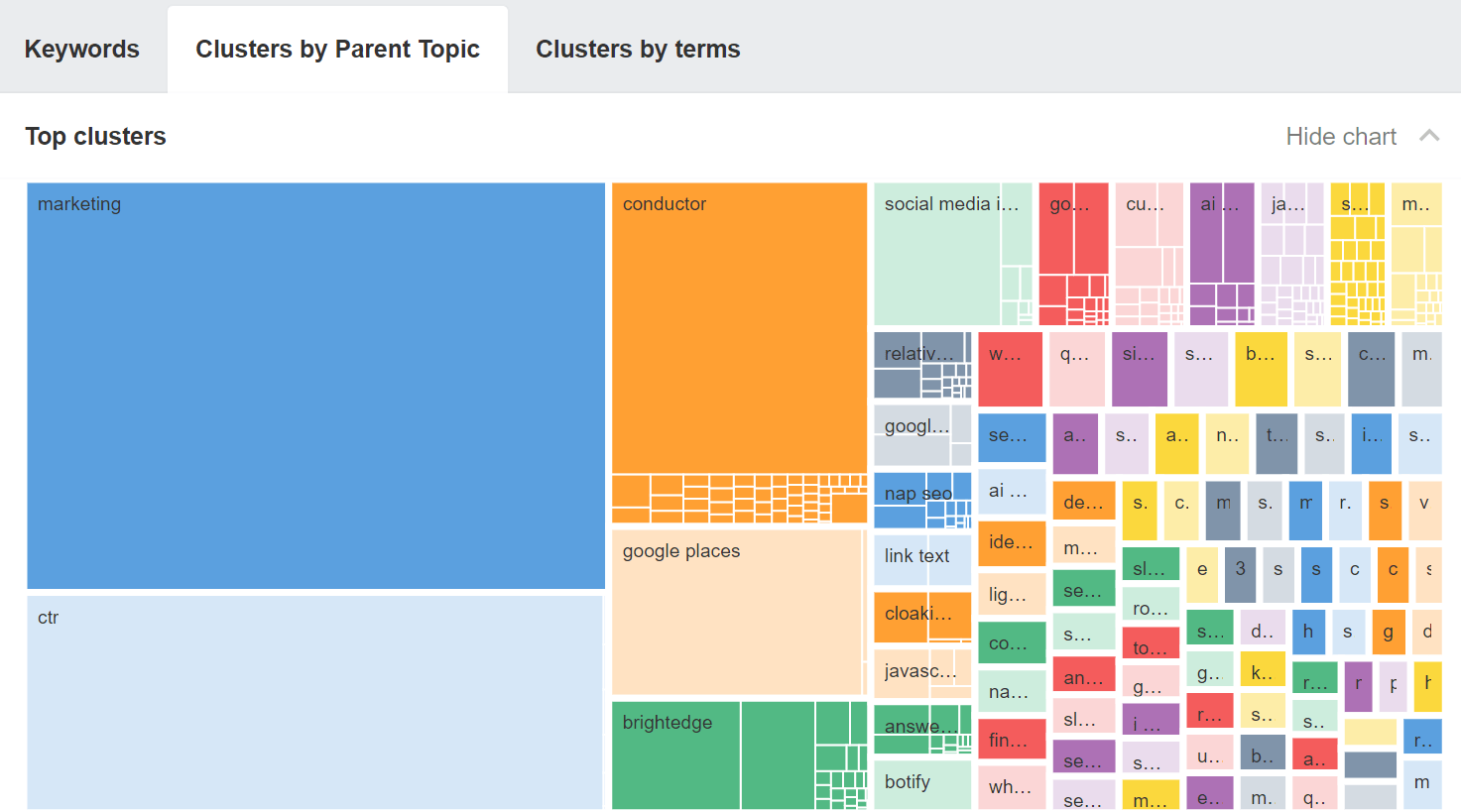
SEOs creating content
For SEOs writing the content, I recommend you talk to the experts or interview them to get their insights. They may have papers, presentations, podcasts, or webinars you can repurpose. The sales team is another great source of information. I’ll also look at what people search around a topic and what other pages cover.
A lot of organizations create copycat content, but that’s just more content that’s the same as what is already out there. This isn’t future-proof. I encourage you to do better. If you can put in a bit more work and add to the information that already exists, your content will be more successful.
Writers creating content
You likely have a team of people who create the content, and you may be able to empower them to do this process themselves.
One of the things that I liked to use with content teams was a card-sorting exercise. Take the data you’re looking at around what people search and what the top pages talk about, and put them on index cards.
Have your content writers organize this in a way that makes sense to them. They’re going to be grouping your data into topics and subtopics and coming up with the content sections or pages they should write.
This helps train people to do this task themselves, and there’s no right or wrong answer as to how it should be organized. You can also show how top pages cover this information as confirmation that it works. As long as you’re writing about what people are looking for, you’re likely to be successful.
Alternatively, your SEOs can provide your writers with an easy-to-digest outline or content brief that covers what should be talked about in the article.
To see how each author or team is doing, you can create Portfolios. This will help identify star performers or writers or teams that might need some additional help.

Experts creating content
If your employees want to write content, you need to find a way to empower them to do so. These are your experts, and while the content they create may require some editing, the insights from these employees are valuable and may not be anywhere else.
If your experts don’t have the time to write content, another option is to interview them or have them review the content you create. Most people are usually happy to give quick insights verbally, which you can then use in your content.
Improve existing content
Making your existing content better can lead to quick wins. Here are some things you can look for.
Content with declining traffic
Apply a filter for “Traffic: Declined” in the Top pages report in Site Explorer and set your time period for the last 6 months or a year. Take a look at pages that lost traffic to see which ones are important to you and that you think you can improve.
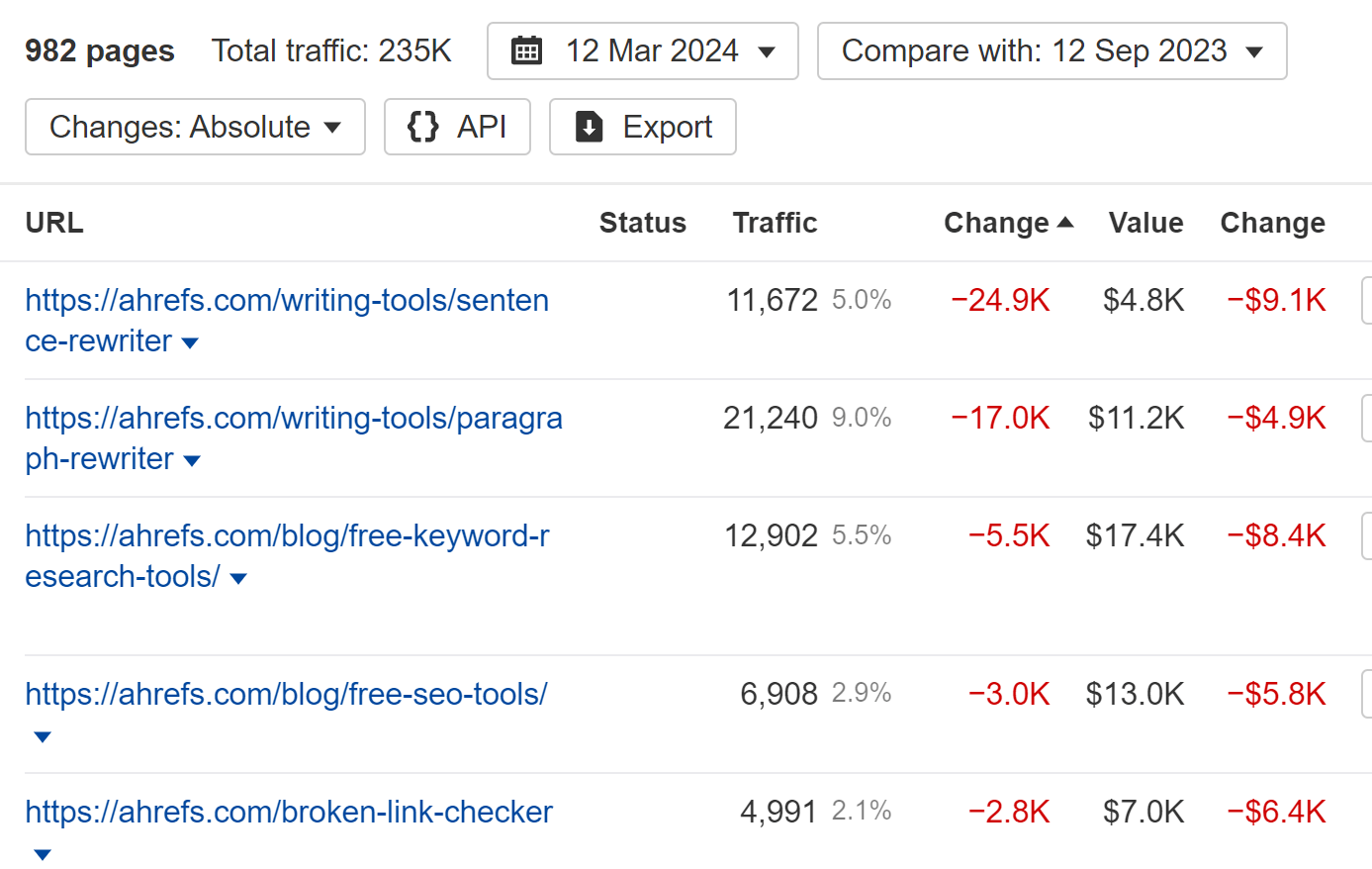
Low-hanging fruit
One common way to prioritize content improvements is to check for low-hanging opportunities, like pages ranking in positions 4-15 for their main keyword. You might be able to quickly improve these pages’ content to rank higher and get more traffic. Use Google Search Console or the Organic Keywords report in Site Explorer to find pages that fit the bill.
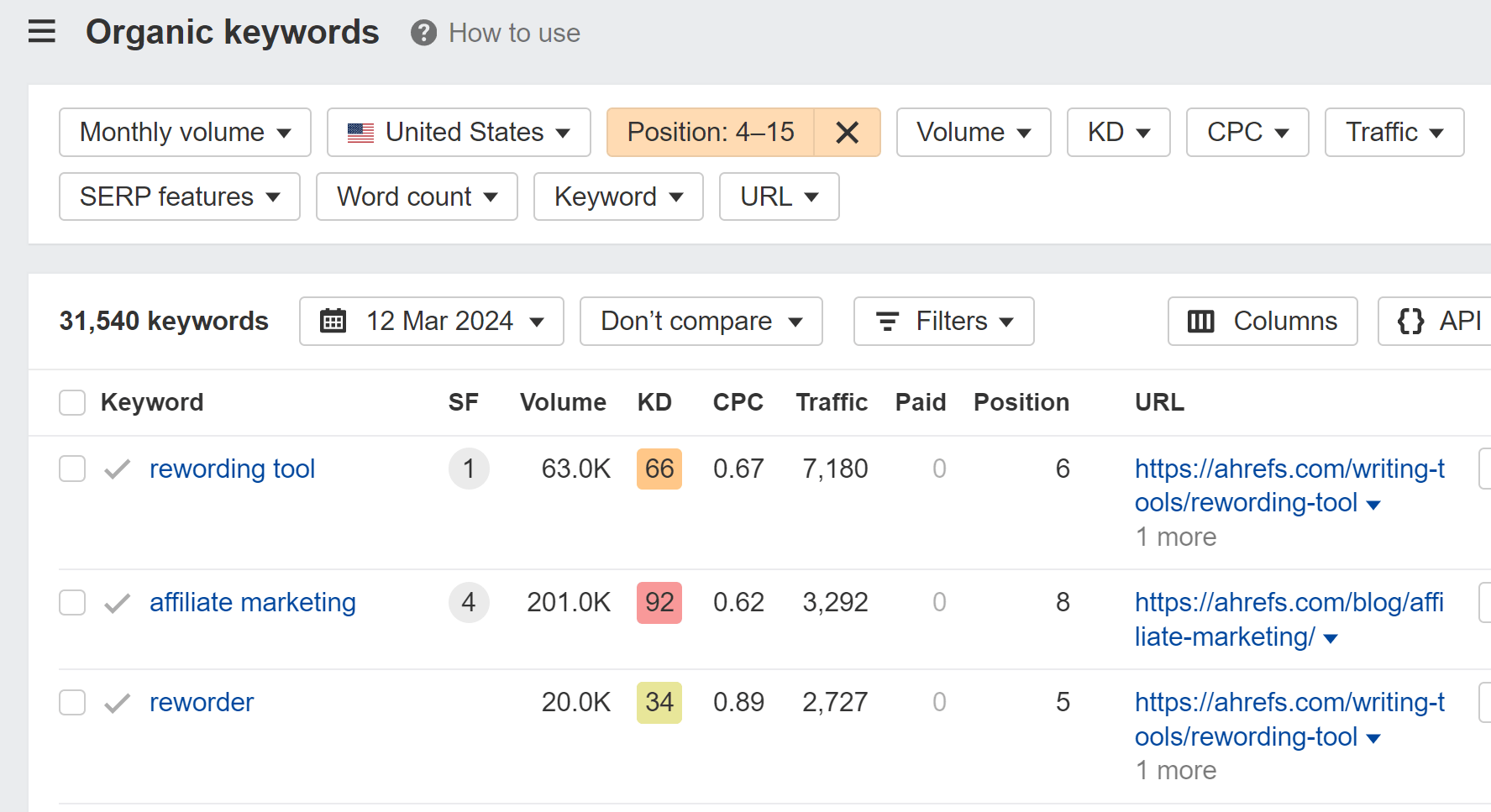
Optimize for featured snippets
For informational content, targeting featured snippets can skyrocket you to the top of the SERPs.
Here’s how to find the easiest opportunities:
- Go to Ahrefs’ Site Explorer
- Enter your domain
- Go to the Organic keywords report
- Filter for keywords in positions #1–5
- Filter for keywords that trigger featured snippets “where target doesn’t rank”
- Look for keywords where your page is missing the answer, then add it
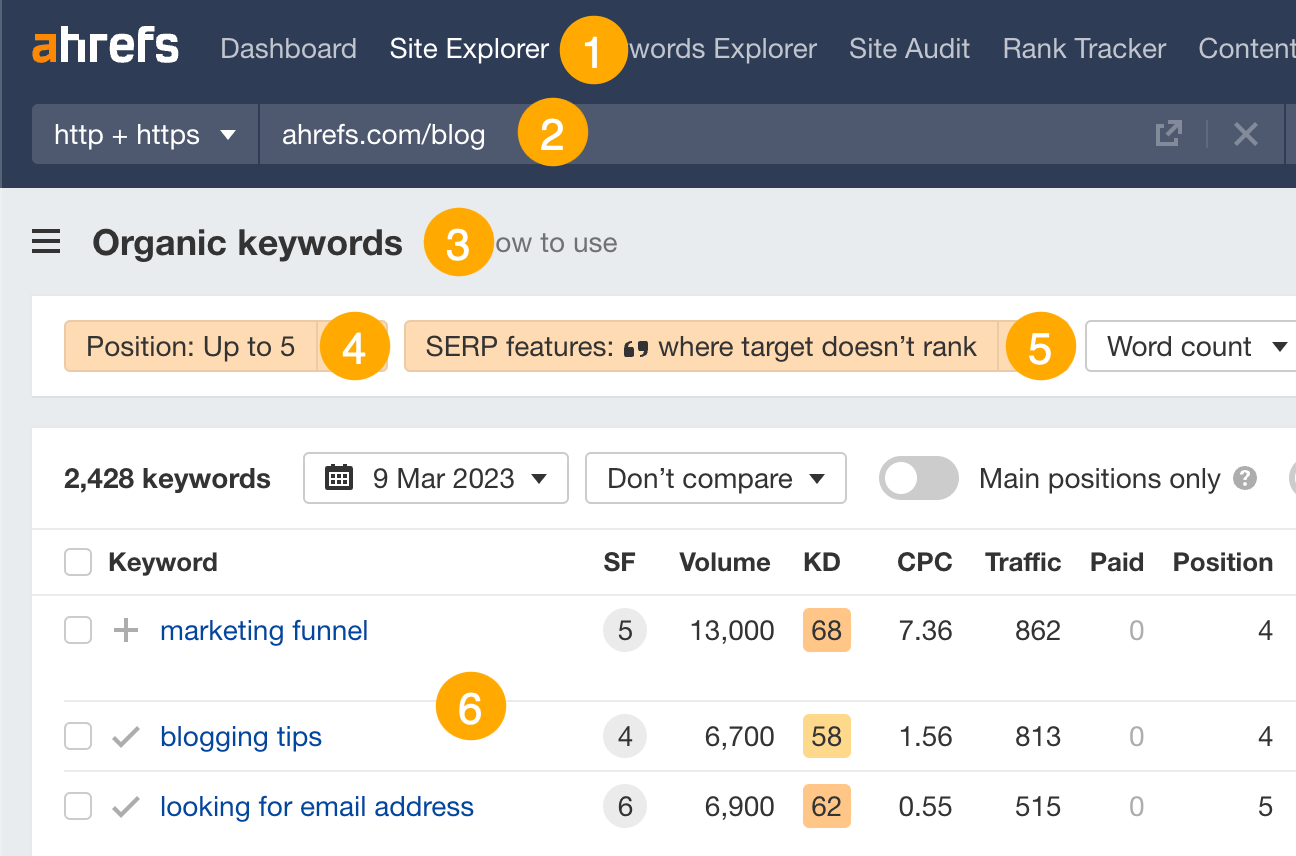
This is arguably the most important section that you can write if you want to rank for informational queries. You can see what is already eligible for a snippet and the kind of things that these snippets mention, along with why one may be better than another. Now you just have to make something that’s better.
Here’s an example: For “how to create content,” the main snippet is from inc.com:
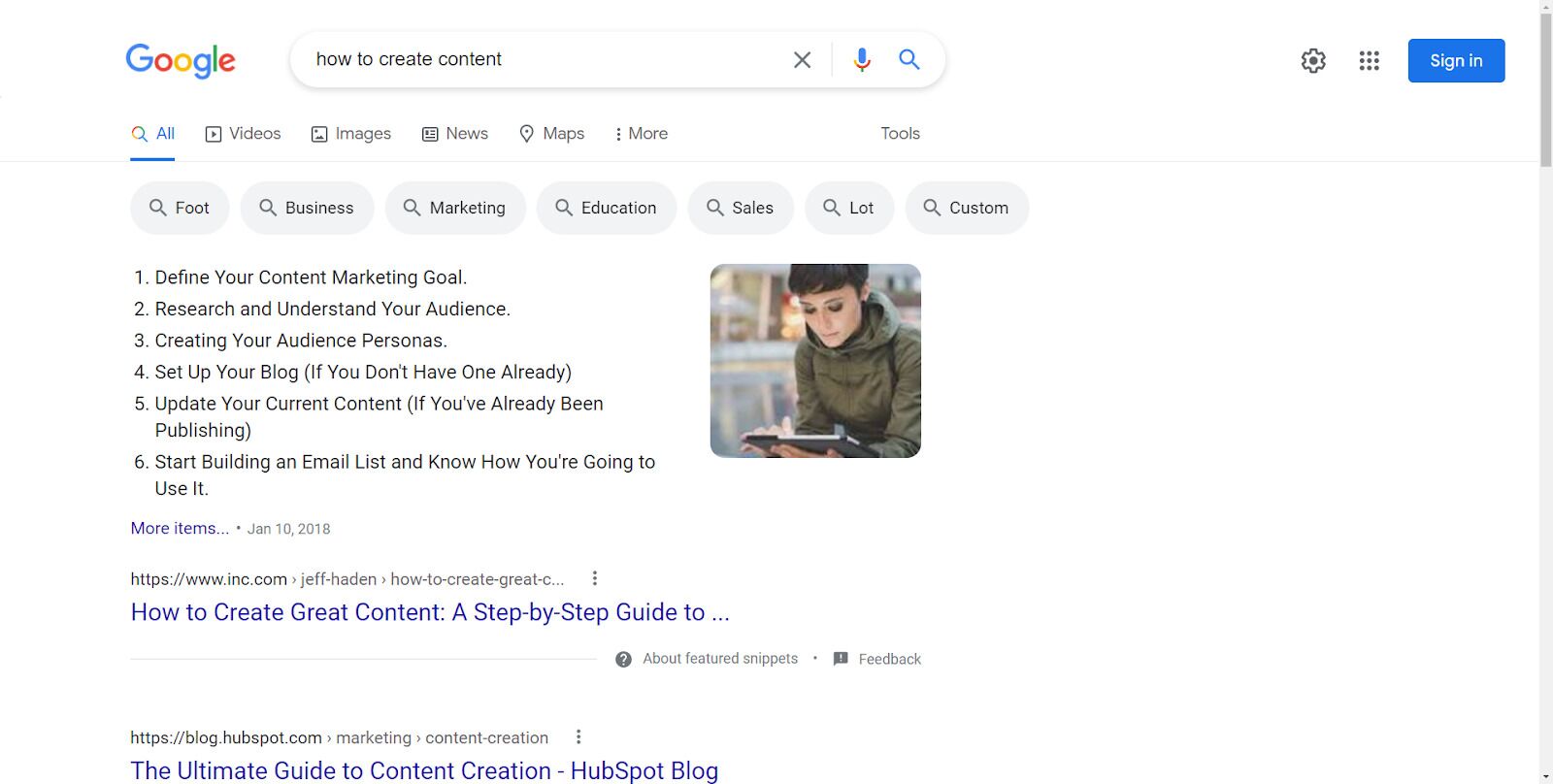
If you append “-inc.com” to your search, you’re removing this site from the results and can see the second eligible featured snippet from hubspot.com:
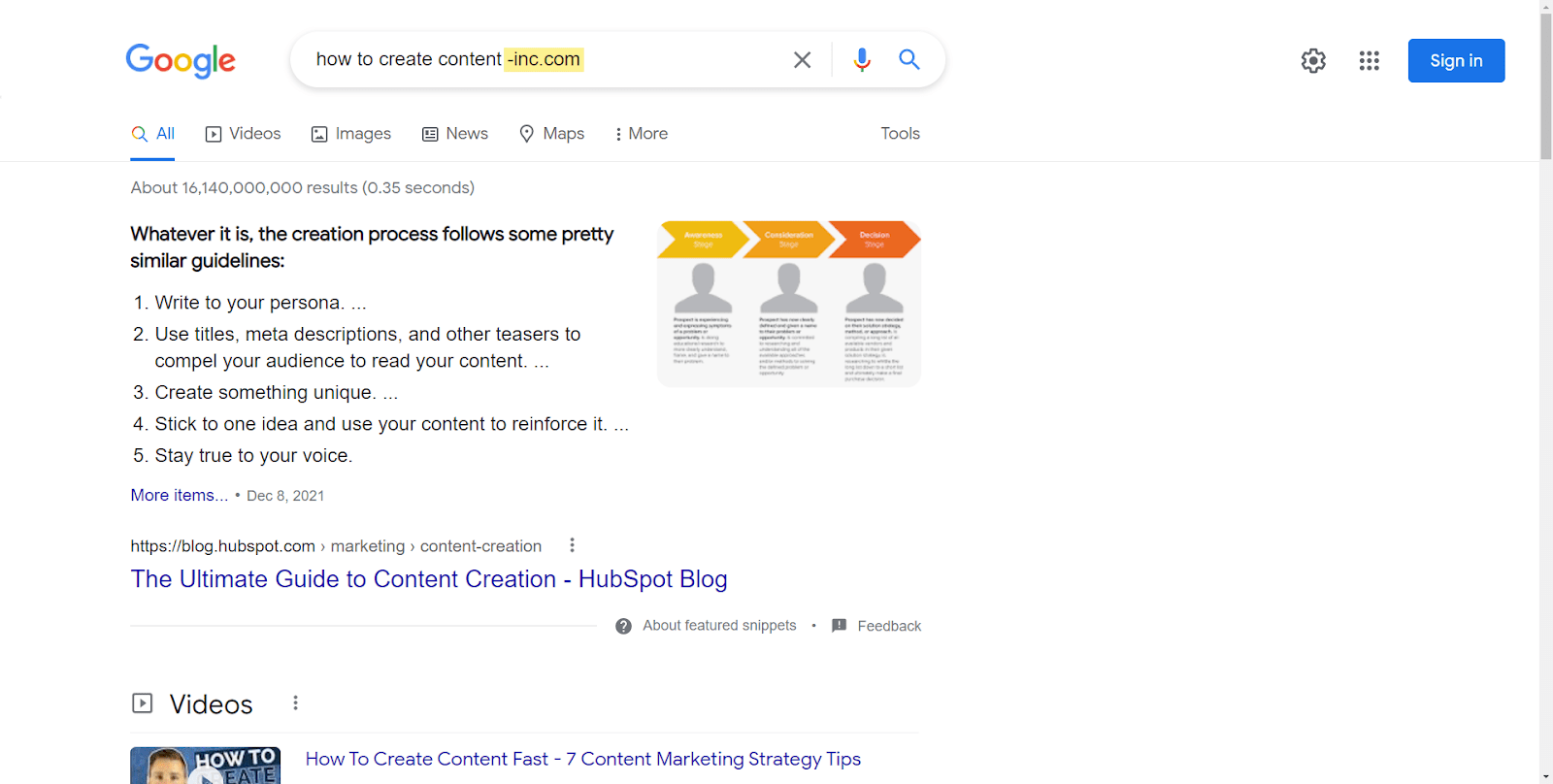
You can repeat this process, removing more sites from the results to see more eligible featured snippets. Also, you can glean insights into what it takes to get featured snippets and figure out why one may be considered better than another.
For some head terms that are more informational in nature, you may have to refine the query as “what is [head term]” for this to work.
Translate successful content
Most enterprise companies operate in many countries and in many different languages, and their enterprise SEO teams will have to work on international SEO. If you have content that’s working well in one language, it’s likely going to work well in another language as well. You should translate successful content for those other languages
We’ve had success with this at Ahrefs despite allocating minimal resources to this process. It’s one of the areas where I expect massive growth as we start to focus on it more.
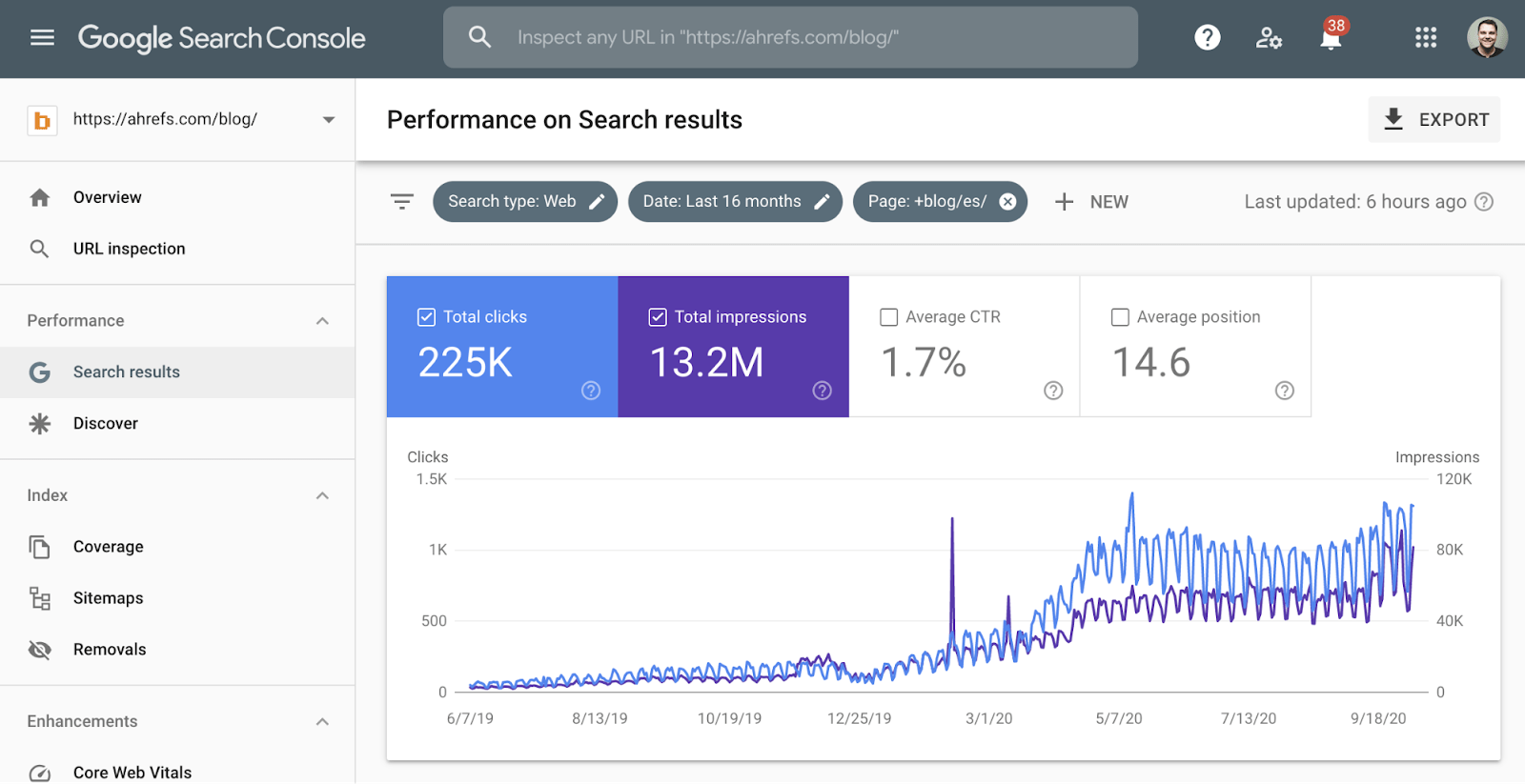
Create branded content, sometimes
You’re probably going to run into content that is too brand-focused, too product-focused, or even too keyword-focused. People will ask you to rank for terms with pages they control that don’t align with search intent. A good example is someone wanting to “sprinkle some keywords” into their product page to rank for an informational term.
You can use the “Identify intents” feature in Keywords Explorer to show the main intent of each term and the percentage of traffic to each result. A product page for “enterprise content management” isn’t likely to rank for this query as the main pages ranking are informational intent.
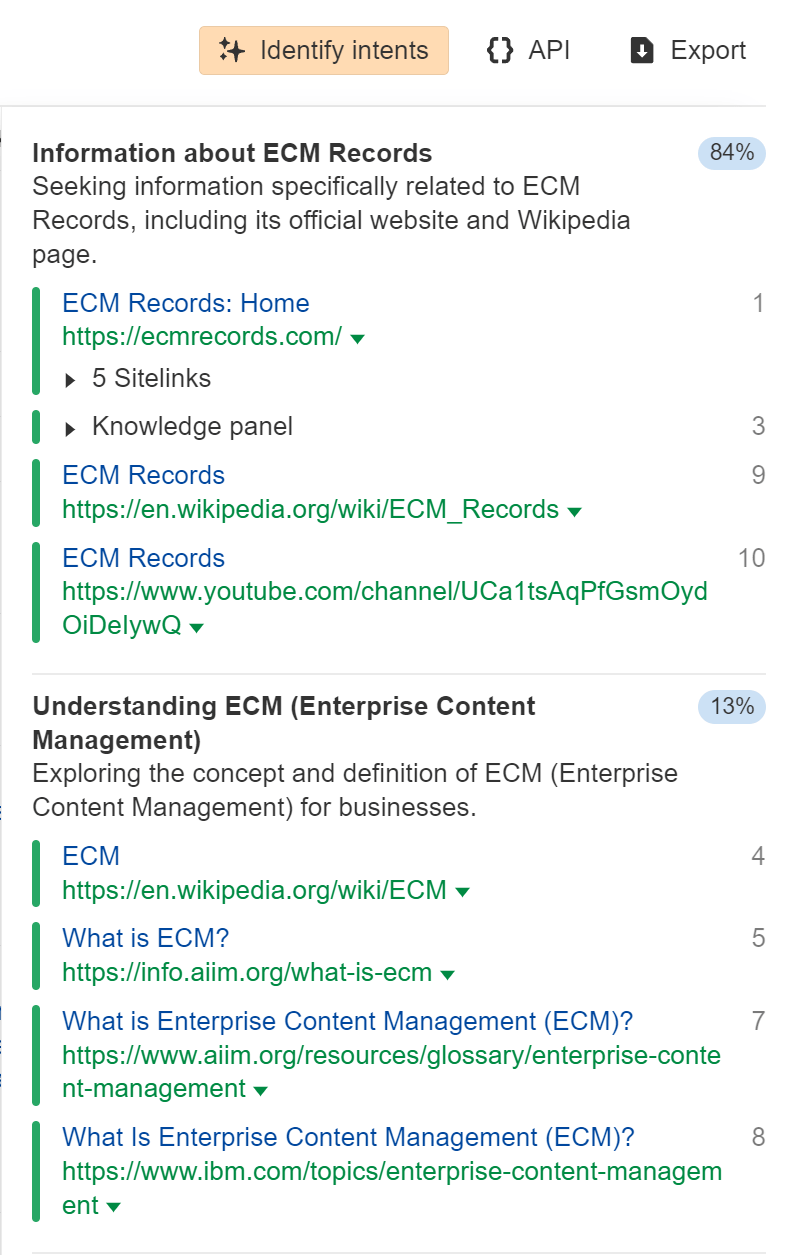
Sometimes, there may be one product page ranking for terms like this where you have a shot at ranking, but it’s usually the most popular product in that position.
There are times you may want to optimize and even create content for branded terms, but this shouldn’t be your usual strategy. Nor should you “sprinkle some keywords” into brand-or-product-focused pages to try to rank for informational terms. These pages may be full of marketing or sales jargon and not have the content you actually need to rank.
Many enterprise websites get a lot of their overall traffic from branded searches, and they may not rank well for unbranded terms. Branded traffic is a good thing. It’s high-quality and converts well, but you should be getting it even without SEO help.
The exceptions to that may be for terms related to companies that were acquired or products that were renamed. You may still need content or documentation to help you keep traffic for those terms and direct people to new versions of the product.
Syndicate content
Content syndication is when one or more third-party sites republish a copy of content that originally appeared elsewhere. It frequently happens with news content, although, to be honest, any popular site is going to have scrapers and enterprise sites may have a paid syndication strategy.
There are a lot of benefits to syndication, including increased reach. Check out our article on content syndication to learn more about it and how to follow best practices.
Redirect relevant old content
In many cases, your old URLs have links from other websites. If they’re not redirected to the current pages, then those links are lost and no longer count for your pages. It’s not too late to do these redirects, and you can quickly reclaim any lost value and help your content rank better.
Here’s how to find those opportunities:
- Paste your domain into Site Explorer (also accessible for free in Ahrefs Webmaster Tools)
- Go to the Best by links report
- Add a “404 not found” HTTP response filter
I usually sort this by “Referring domains.”
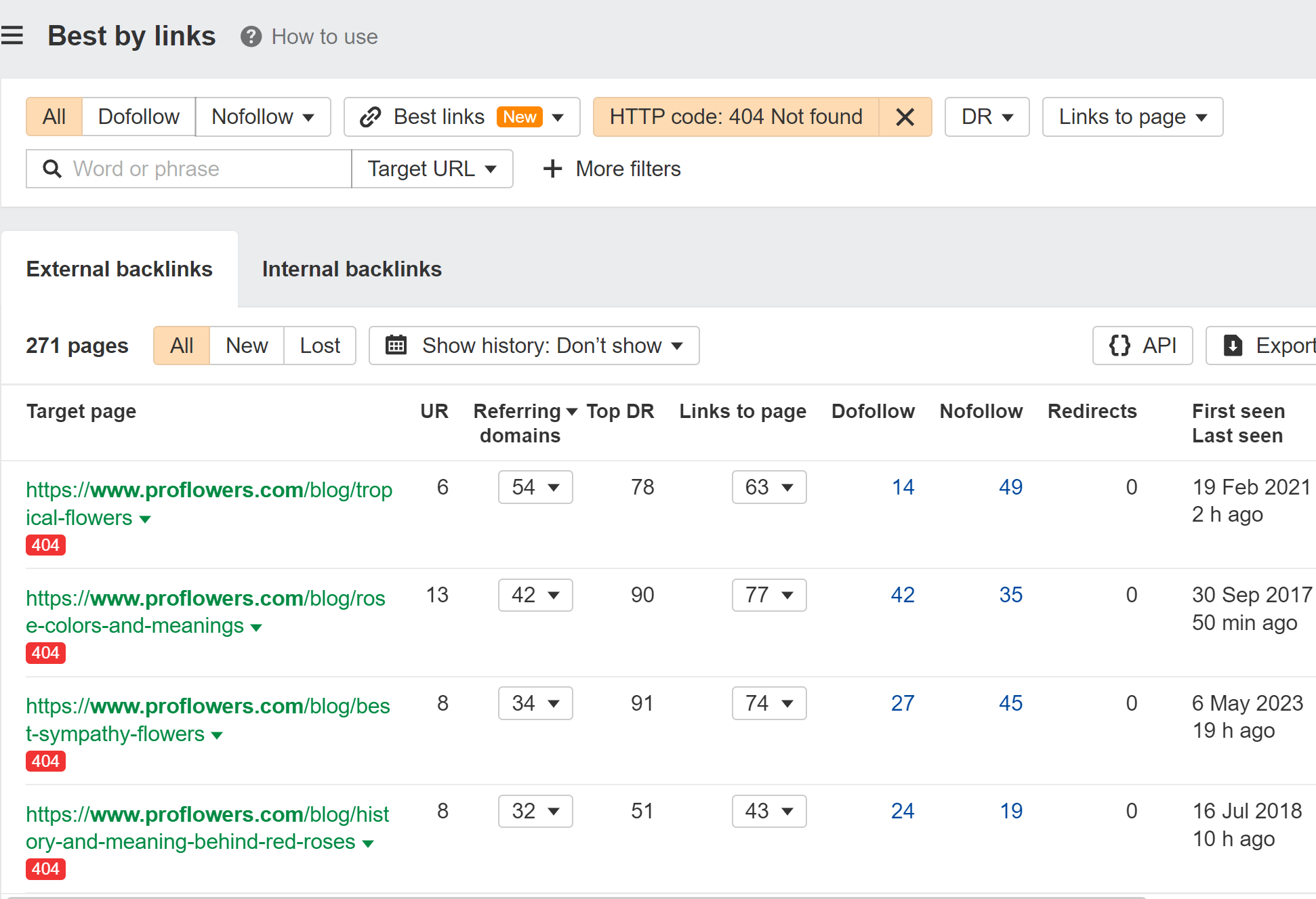
Build and improve internal links
I’ve always found internal links to be a powerful way to help pages rank higher. Even these links may be difficult to get in an enterprise environment.
Sometimes different people are responsible for different sections of the website or even different pages, which can make internal linking time-consuming.
On top of the political hurdles, the process for internal linking can be a bit convoluted. You either have to know the site well and read through various pages looking for link opportunities or follow a process that involves a lot of scraping and crawling to find opportunities.
At Ahrefs, we’ve made this simple, scalable, and accessible so anyone can find these opportunities with our tool in Site Audit. We look at what your pages are ranking for and suggest links from other pages on your site that talk about those things.

I’d also recommend watching out for opportunities to use better link anchor text. It’s common for page creators to overuse generic link anchor text such as “learn more,” “read more,” or “click here.” You can look for usage of this kind of generic copy in the Internal anchors report in Site Explorer.
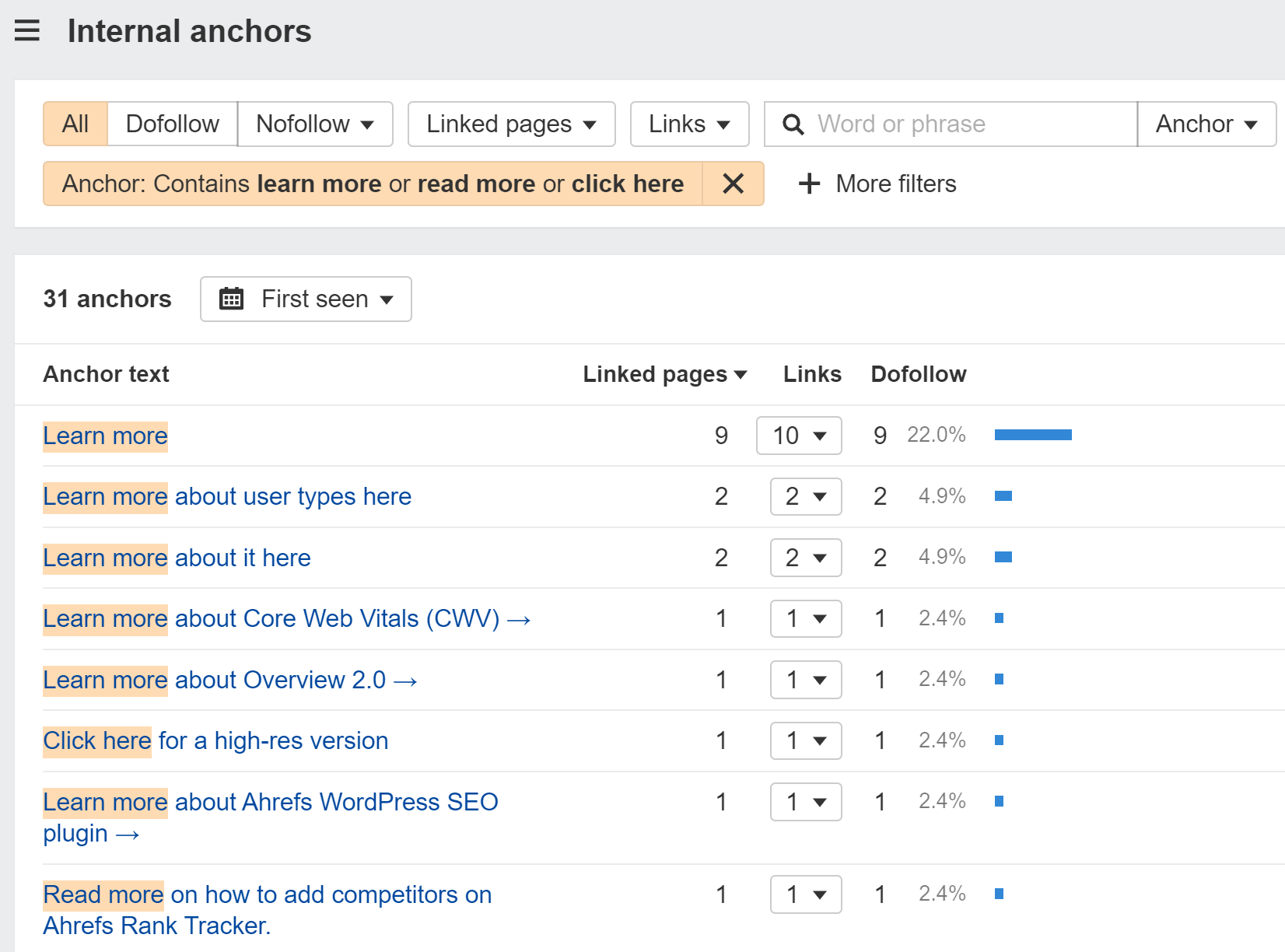
Create “vs” pages
Creating content that compares you against competitors can be difficult to create in an enterprise environment because of all the legal hurdles. I still think it’s useful to push for these kinds of pages so that you can control the narrative.
There are ways you can do this without having giant tables comparing each feature. Those are always biased anyway. For instance, on our vs page, we show what users think of us and talk about the quality of our data and unique features.
This page has done well for us, and I believe we will create more pages like it in the future.
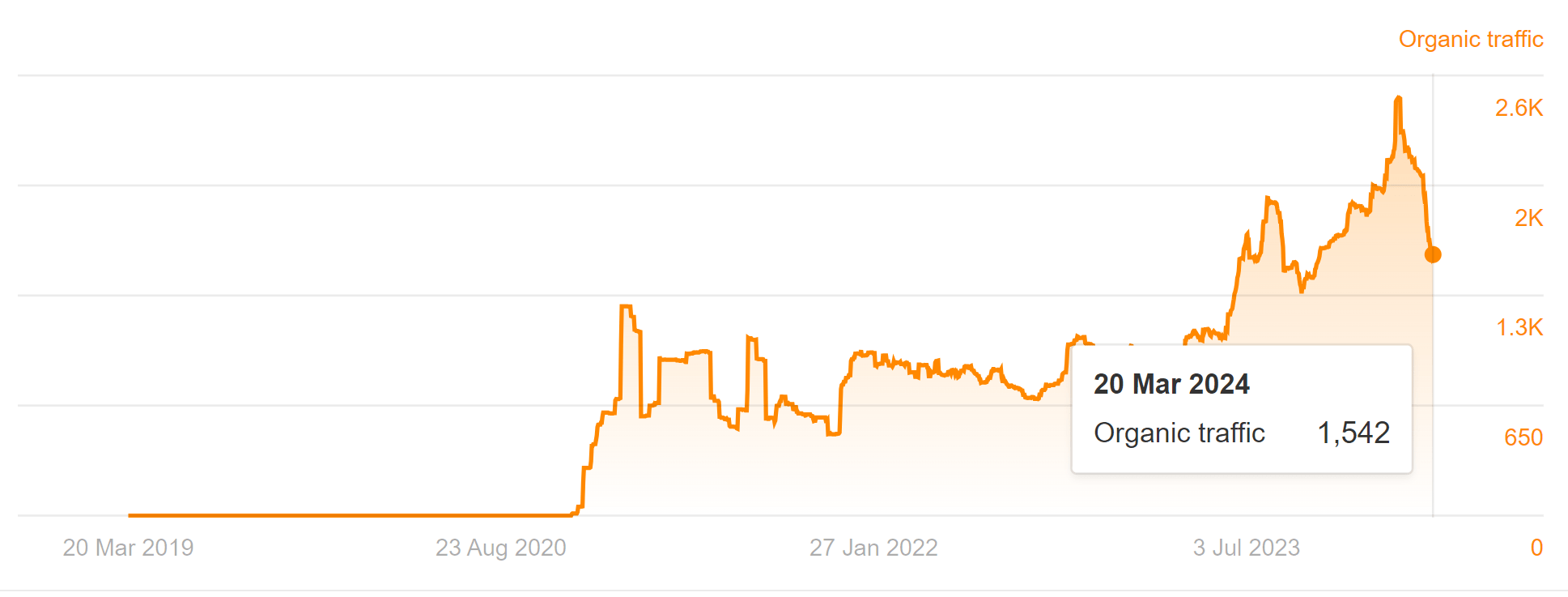
Create free tools
If you can create free tools around your product or data, you can use it as a lead-gen tactic for your main products.
We use this strategy at Ahrefs, and some of our most trafficked pages are from free tools. We even created a bunch of free writing tools, which we are starting to monetize.

Create programmatic content
If you have the ability to create good pages programmatically using your data, it can be a great way to scale quickly.
We had some success with a small amount of effort by re-using components to create “SEO for x” pages, where x is different types of business. Most of these are ranking well already, but at some point I believe we will put in more effort and pull more data to make these pages even better.
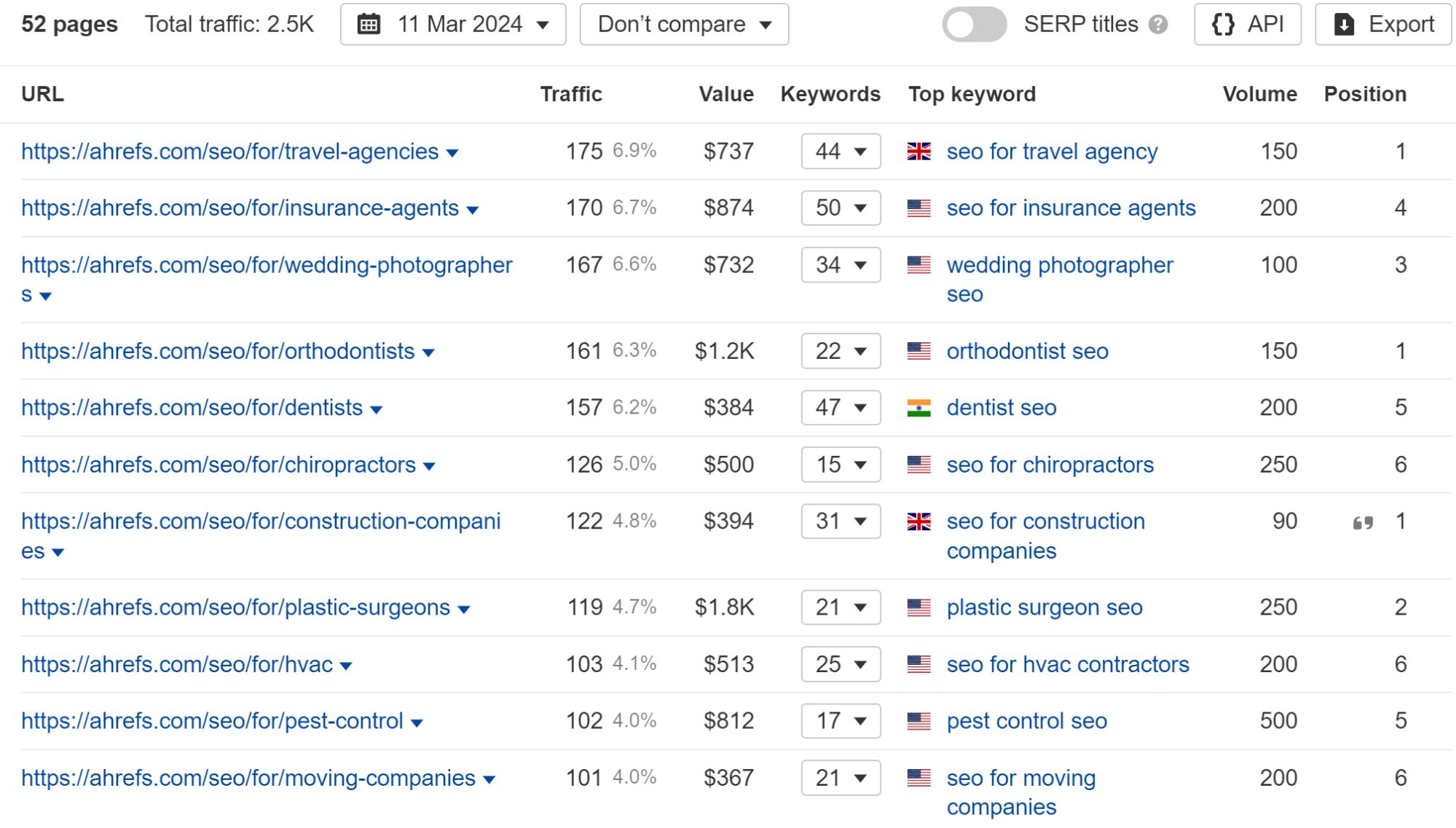
We’re working on some additional programmatic plays that showcase our data even more, and I expect will drive a lot of leads.
Create video content
Video content can work extremely well for businesses. Sam Oh drives tons of leads for Ahrefs.
Ahrefs YouTube has over 500k subscribers with less than 300 published videos. Many of those videos have over 1 million views!
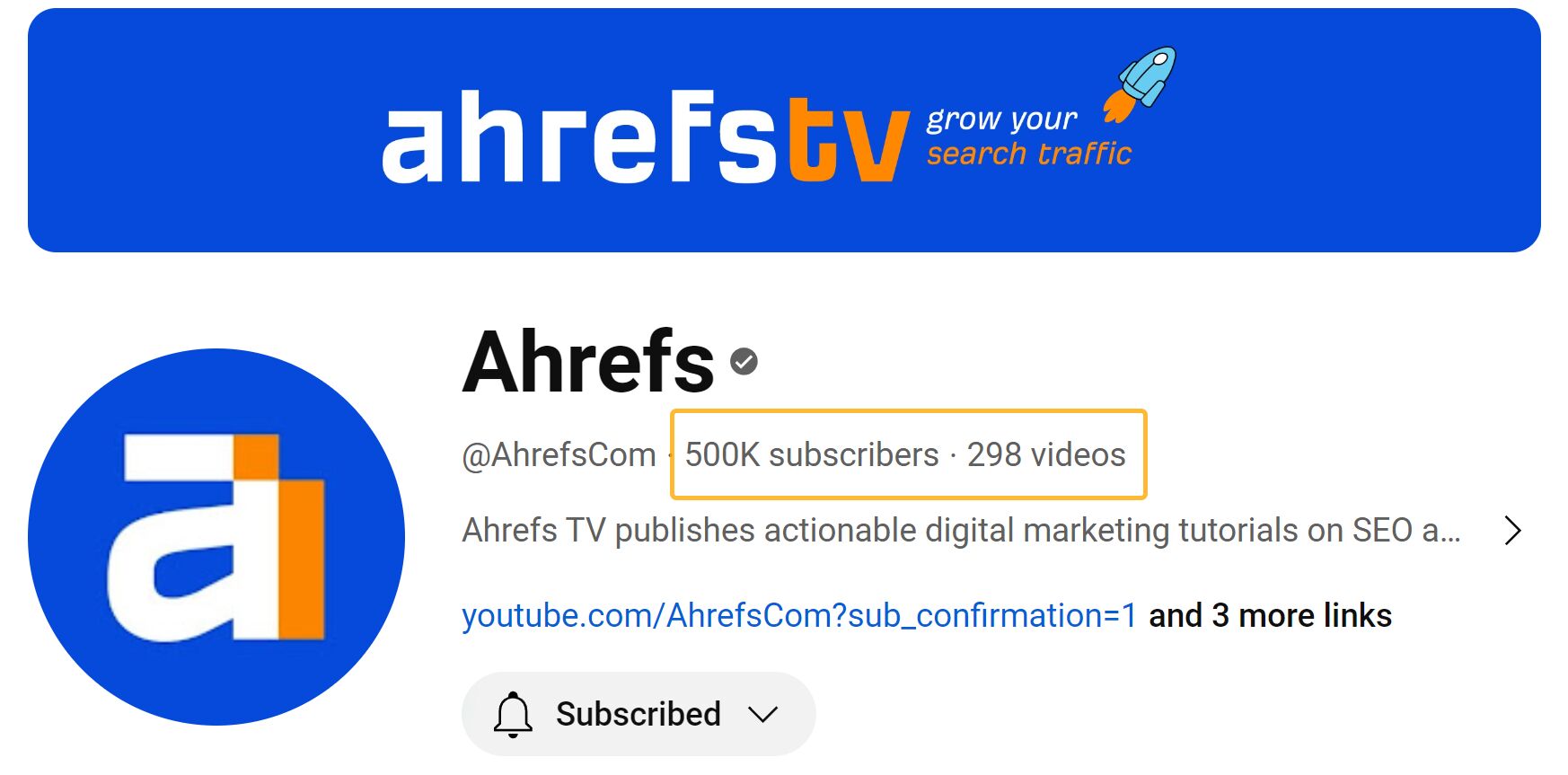
In my past jobs, I’ve always treated videos the same way I would blog content and structured the talking points around the things people are searching for and want to know. This worked extremely well, even for industries where people were convinced that folks in the industry didn’t watch videos.
A lot of link building happens without SEO at the enterprise level. Companies are usually really active and doing different things. You may see TV commercials, hear radio ads, have a lot of new content. Then there’s public relations, social media, paid advertising, content syndication, events, corporate partnerships, influencers, celebrity advertising, affiliate programs, and more.
Most links will probably happen without you, but you can help guide many of the teams in charge of these channels with best practices.
You have a lot of different options for link building in an enterprise environment. If you’re not sure where to start, I’d check out the Links section in Opportunities report in Site Explorer. This report has shortcuts to other reports with filters applied, that help you with some common tasks.
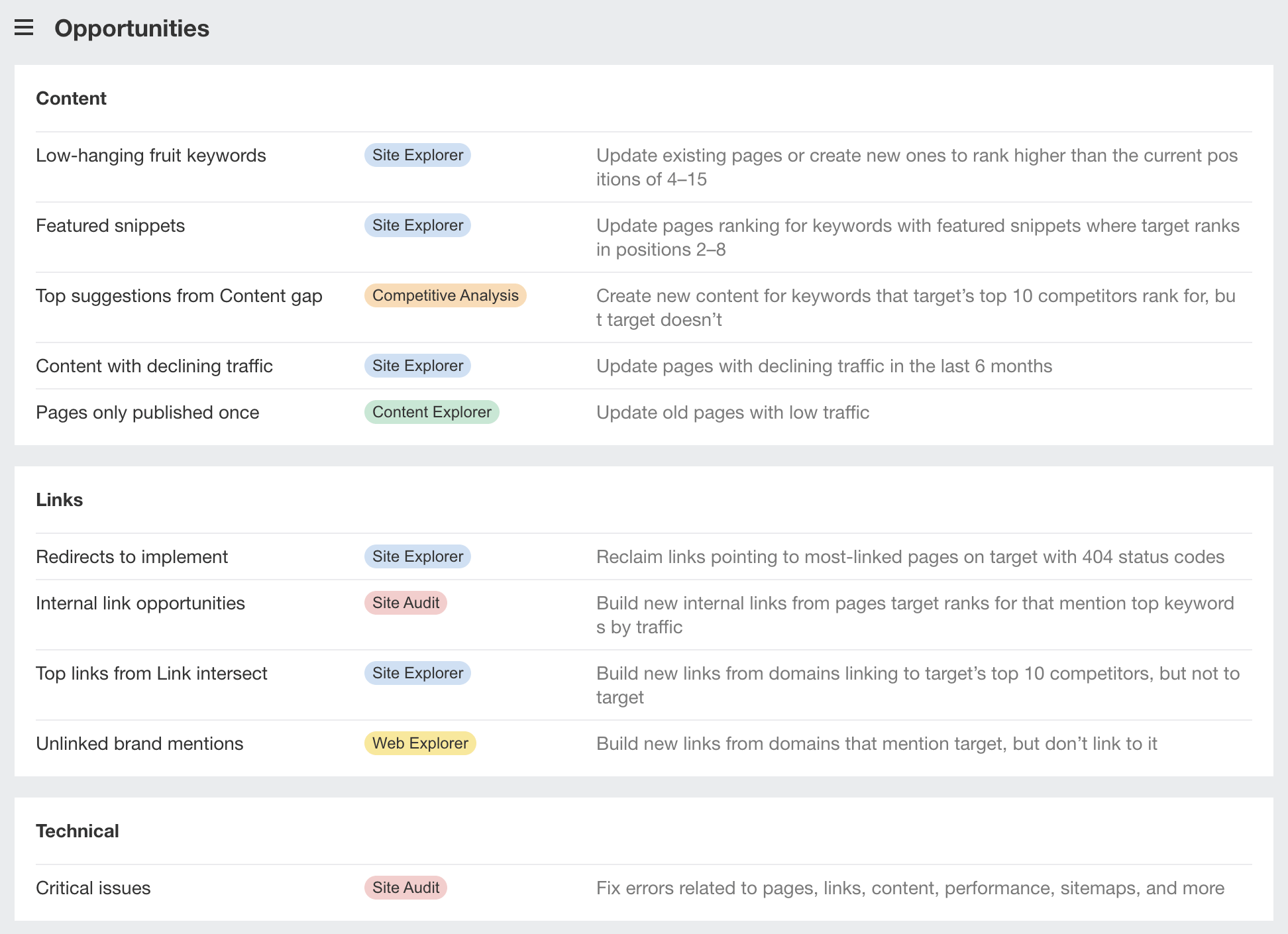
Here are some of the enterprise link building tactics you may want to try.
Create linkable assets
In SEO, we use the terms “linkable asset” or “link bait” to refer to content that is strategically crafted to attract links. Such linkable assets can take on many different forms:
- Industry surveys
- Studies and research
- Online tools and calculators
- Awards and rankings
- How-to guides and tutorials
- Definitions and coined terms
- Infographics, GIFographics, and “Map-o-graphics”
You can also use any industry-famous employees or thought leaders you have to create interesting quotes that might be linked.
There’s also a phenomenon where high-ranking pages get linked to more over time. If your content is good enough to get you near the top, you’re more likely to get more links. Tim Soulo calls this the vicious circle of SEO.
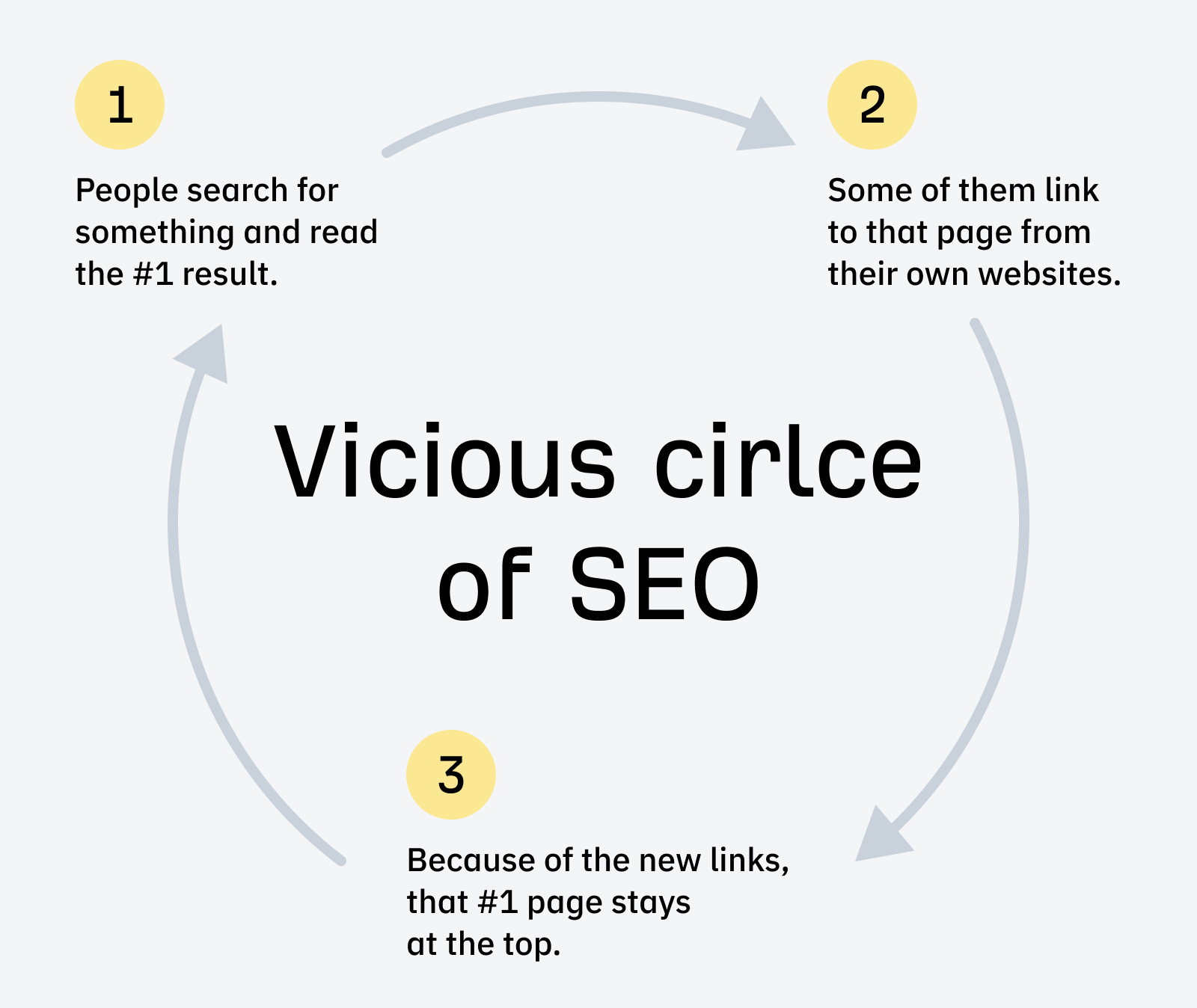
For more ideas, check out our guide to enterprise content marketing.
Combine similar content to create a stronger page
Keyword cannibalization is when a search engine consistently swaps rankings between multiple pages or when multiple pages rank simultaneously for the same keyword but are similar enough to be consolidated. Consolidating similar content into comprehensive guides or pillar pages can improve your chances of ranking and earning links. To do that, you usually combine the content and redirect one page to the other.
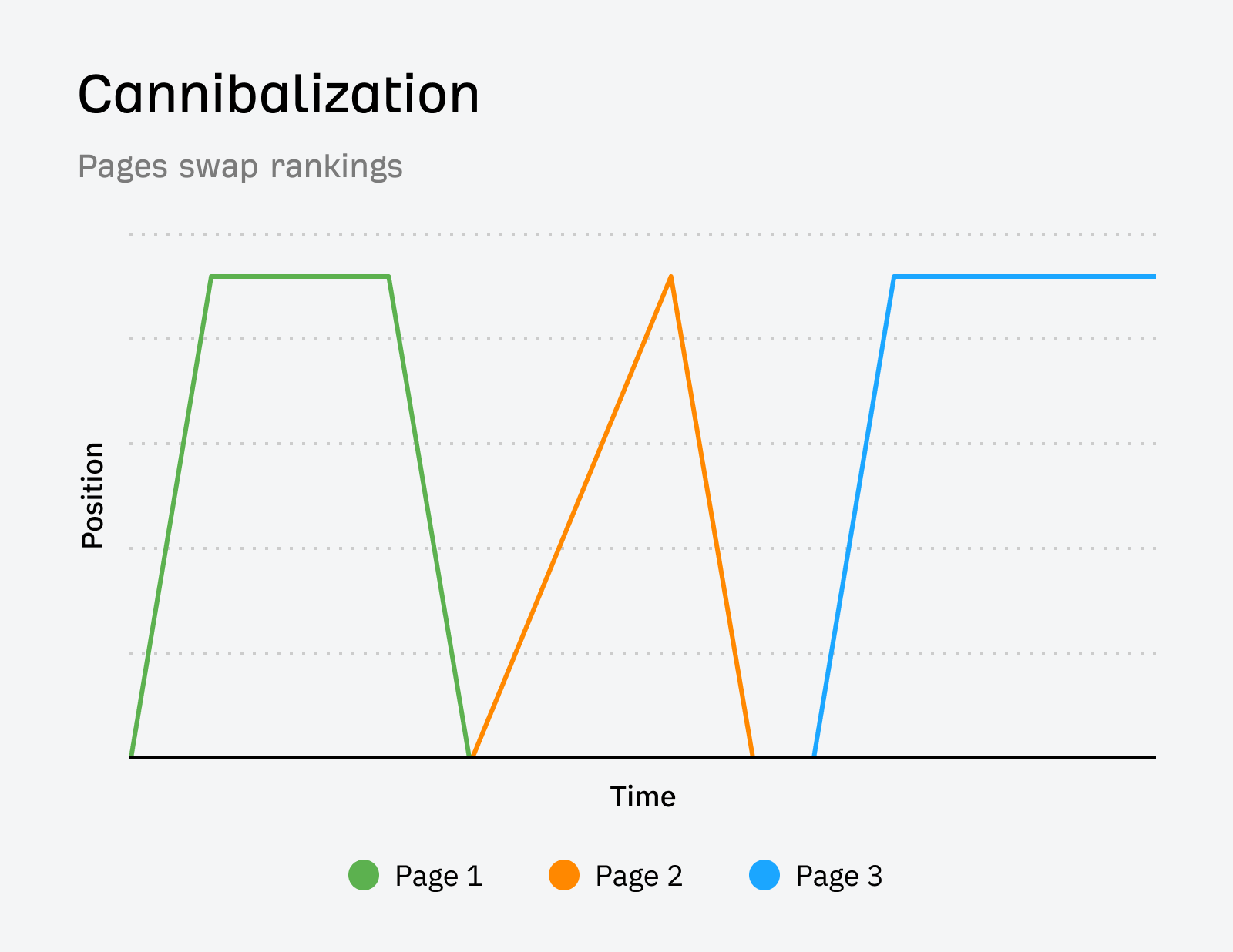
Promote your content
The more visibility your content gets, the more links you are likely to get naturally. Leverage those other teams I talked about earlier to promote your content on social and maybe paid media. Use influencer relationships to amplify your reach. Use your PR teams for potential media coverage.
Keep in mind that these other teams are busy and have their own priorities as well. Be selective on what you ask them to promote. If you ask for them to promote everything, they’re likely to promote nothing.
Go after unlinked brand mentions
Unlinked brand mentions are online mentions (citations) of your brand—or anything directly related to your brand—that do not link back to your site.
Enterprise companies tend to get talked about a fair bit, and each one of those mentions offers a chance to get a link. Even if there’s not initially a link, it doesn’t hurt to ask for one. You can use Content Explorer to find these mentions on the web, and the inbuilt filter for highlighting unlinked domains to hone in on unlinked mentions.
You can also look for unlinked brand mentions of key employees, famous quotes of theirs, or statistics from your studies.

Recover links with link reclamation
Sites, and the web in general, are always changing. We ran a study that found that ~two-thirds of links to pages on the web disappeared in the nine-year period we looked at.
In many cases, your old URLs have links from other websites. If they’re not redirected to the current pages, then those links are lost and may no longer count for your pages.
It’s not too late to do these redirects, and you can quickly reclaim any lost value and help your content rank better.
Here’s how to find those opportunities:
- Paste your domain into Site Explorer
- Go to the Best by links report
- Add a “404 not found” HTTP response filter
I usually sort this by “Referring domains.”
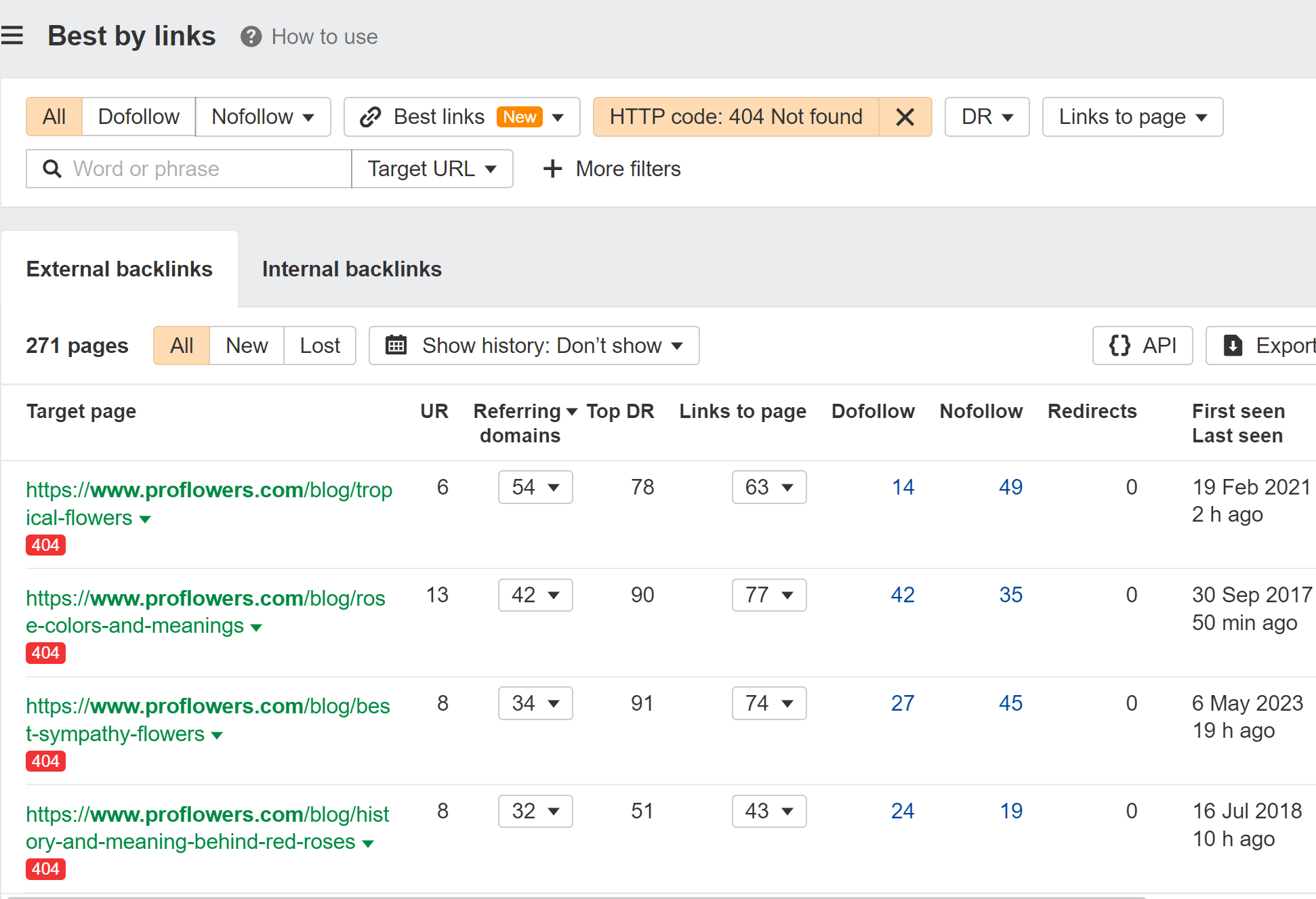
I even created a script to help you match redirects. Don’t be scared away; you just have to download a couple of files and upload them. The Colab notebook walks you through it and takes care of the heavy lifting for you.
While this script could be run periodically, if you’re constantly having to do redirects, I would recommend that you automate the implementation. You could pull data from the Ahrefs API and visits from your analytics into a system. Then create logic like >3 RDs, >5 hits in a month, etc. and flag these to be redirected, suggest redirects, or even automatically redirect them.
If you had redirects in place for a year or more already, the value is likely already consolidated to the new pages. That’s what Google recommends and seemed to be true when we tested it. You could also add a flag for “was redirected” into the automation logic that checks if the page was previously redirected for a year to account for this.
Copy competitor links and strategies
There are a few different ways to do this. The usual recommendation for SEOs would be a link intersect report, which we have, but it’s pretty noisy for large sites.
What I would recommend instead is the Best by links report in Site Explorer.
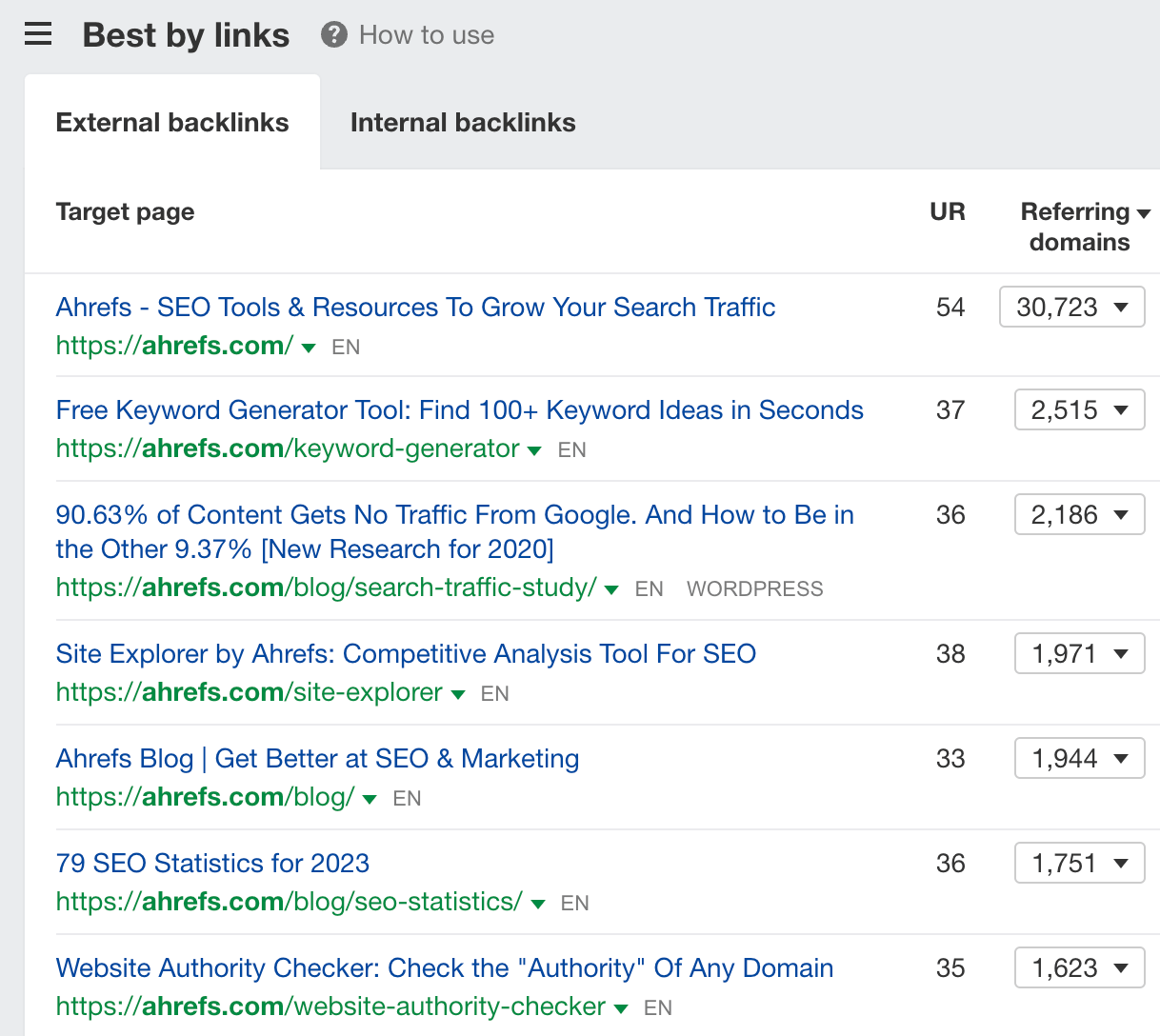
This is going to show you the most linked pages on a website. For us, that’s our homepage, some of our free tools, and our blog and data studies.
Another option is the Site Structure report in Site Explorer sorted by Referring domains or Referring pages.

This lets me quickly see that things like our blog, free tools, glossary, and training academy videos are all well linked.
Build internal links
I’ve always found internal links to be a powerful way to help pages rank higher.
Even these links may be difficult to get in an enterprise environment. Sometimes different people are responsible for different sections of the website, which can make internal linking time-consuming and may require meetings and a lot of follow up to get internal linking done.
On top of the political hurdles, the process for internal linking can be a bit convoluted. You either have to know the site well and read through various pages looking for link opportunities, or you can follow a process that involves a lot of scraping and crawling to find opportunities.
At Ahrefs, we’ve made this simple, scalable and accessible so anyone can find these opportunities. The easiest way to see internal link opportunities is with the Internal Link Opportunities report in Site Audit. We look at what your pages are ranking for and suggest links from other pages on your site that talk about those things.

I’d also recommend watching out for opportunities to use better link anchor text. It’s common for page creators to overuse generic link anchor text such as ‘learn more,’ ‘read more,’ or ‘click here.’ You can look for usage of this kind of generic copy in the Internal anchors report in Site Explorer.

Build links from other websites you own
If your company owns multiple websites, you’ll want to add links between them where it makes sense. Ultimately you may want to consolidate the content into one site, but that’s not always feasible. Even if it is, it may not happen within a reasonable timeframe, so you may want to add links between the sites in the meantime.
This can be abused and goes into a gray area, but for the most part, if you’re linking naturally to relevant pages you’ll be fine.
Buy other companies websites
I wrote all about SEO for mergers and acquisitions. When you buy another company, you inherit their content and their links. This opens some nice options for consolidating content and links to stronger pages.
Enterprise sites can have complex infrastructures and a lot of legacy systems in place. There may even be many different teams responsible for maintaining everything, which means the technical environment and the political environment can be tricky. Sometimes pages or sections of the site will have issues that never get fixed because doing so is too expensive.
One mistake can keep millions of pages out of the index or remove an entire site from search results. There are so many moving parts, so much that can go wrong, and so many times that you’ll need to choose the least bad option.
You won’t have control of everything. Just do the best you can and when you have the opportunity, make the most future-proof decision you can.
When focusing on technical SEO projects, you’re likely to have an unlimited number of things fighting for your attention. You must learn how to prioritize tasks and focus on the most significant issues. While it would be great if you could get everything technically perfect, it’s simply not realistic. One of the things I like about Ahrefs’ Site Audit is that you can choose to ignore issues that you don’t find important.

Run a free technical SEO audit
In the world of enterprise SEO, you’re likely going to rely on many different teams to get work done. You’re going to have to be opportunistic and help many of these teams on their own timeline, when they are ready to go, but that doesn’t mean you can’t prepare for them ahead of time.
You’ll want to find out how these teams work, their processes and tools, and opportunities you may have to interact with them like scrum calls, team calls, or office hours you may be able to join. If you can be very clear in your communication with the team, it will make the process a lot easier. Learn to write tickets in their project management system that communicates the problem, expected outcomes, and the value of implementing the changes.
One final tip is that if you don’t seem to be making progress on projects, try to sell the changes you want to make as A/B testing. Many companies want to do more testing, and you can “test” your SEO changes to see the impact they have. With a measurable impact, you can argue for a more permanent fix, but in the meantime it’s technically fixed.
I wanted to cover some projects to help you get started with technical SEO in an enterprise. Of course you may want to start with a technical SEO audit first and check out our guide on enterprise technical SEO.
Check indexing
Priority - high
You probably have some pages indexed that shouldn’t be, and many pages noindexed that should be indexed. Canonicalization is another issue to check to make sure the version of a page you want indexed is the one that is indexed.
First, check the Indexability report in Site Audit for “Noindex page” warnings.

Google can’t index pages with this warning, so it’s worth checking they’re not pages you want indexed.
You can also check the Site Structure report in Site Explorer for any pages with organic traffic that shouldn’t have traffic.
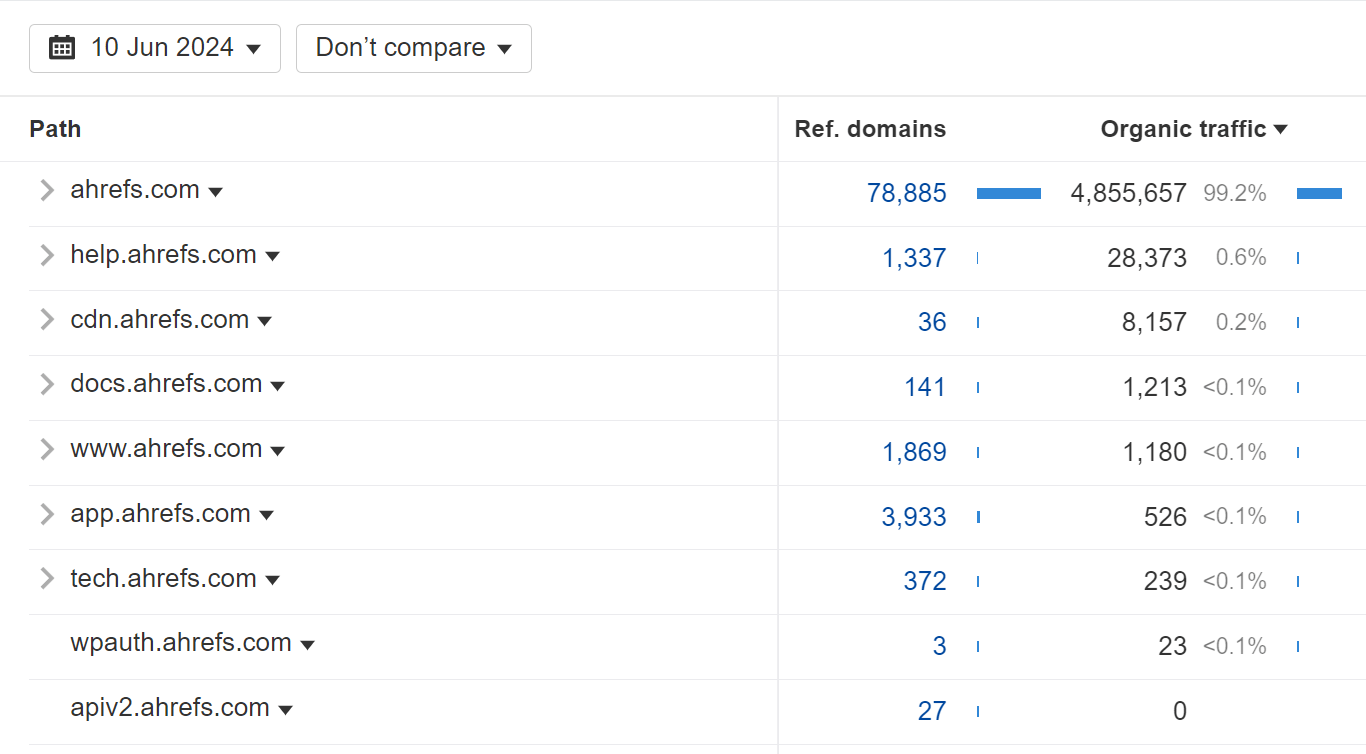
Recover links with link reclamation
Priority - high
Sites, and the web in general, are always changing. We ran a study that found that ~two-thirds of links to pages on the web disappeared in the nine-year period we looked at.
In many cases, your old URLs have links from other websites. If they’re not redirected to the current pages, then those links are lost and may no longer count for your pages.
It’s not too late to do these redirects, and you can quickly reclaim any lost value and help your content rank better. I normally assign a dollar amount like $400 per referring domain in order to make a business case for this.
Here’s how to find those opportunities:
- Paste your domain into Site Explorer
- Go to the Best by links report
- Add a “404 not found” HTTP response filter
I usually sort this by “Referring domains.”

I even created a script to help you match redirects. Don’t be scared away; you just have to download a couple of files and upload them. The Colab notebook walks you through it and takes care of the heavy lifting for you.
While this script could be run periodically, if you’re constantly having to do redirects, I would recommend that you automate the implementation. You could pull data from the Ahrefs API and visits from your analytics into a system. Then create logic like >3 RDs, >5 hits in a month, etc. and flag these to be redirected, suggest redirects, or even automatically redirect them.
If you had redirects in place for a year or more already, the value is likely already consolidated to the new pages. That’s what Google recommends and seemed to be true when we tested it. You could also add a flag for “was redirected” into the automation logic that checks if the page was previously redirected for a year to account for this.
Add internal links
Priority - high
I’ve always found internal links to be a powerful way to help pages rank higher.
Even these links may be difficult to get in an enterprise environment. Sometimes different people are responsible for different sections of the website, which can make internal linking time-consuming and may require meetings and a lot of follow up to get internal linking done.
On top of the political hurdles, the process for internal linking can be a bit convoluted. You either have to know the site well and read through various pages looking for link opportunities, or you can follow a process that involves a lot of scraping and crawling to find opportunities.
At Ahrefs, we’ve made this simple, scalable and accessible so anyone can find these opportunities. The easiest way to see internal link opportunities is with the Internal Link Opportunities report in Site Audit. We look at what your pages are ranking for and suggest links from other pages on your site that talk about those things.

Add schema markup
Priority - high
I’m a fan of schema markup as long as it gets you a search feature. Check out our guide to schema markup to see which ones you should be implementing. There are some cool tools now that can even suggest schema markup based on what is seen on the page.
Fix Page Experience
Priority - medium
While many of these aren’t necessarily going to move the needle for SEO, they are good for users and how they experience your website, so they’re worth working on.
- Core web vitals. This is how fast your pages load.
- HTTPS. You want your pages to be secure. A surprising number of sites, >6%, redirect HTTPS to HTTP.
- Mobile-friendliness. Are your pages usable on mobile?
- Interstitials. You don’t want intrusive interstitials, or those that take up a good chunk of the screen.
We cover most of these in Site Audit. For example, we pull PageSpeed Insights data so you get actual Chrome User Experience Report (CrUX) metrics for Core Web Vitals as well as Lighthouse metrics in Site Audit.

We also flag mobile SEO issues.

General website health / maintenance
Priority - low
These may not have much impact on SEO, but can be an important consideration for user experience.
- Broken links. Find them and fix them.
- Redirect Chains. Google will follow up to 10 hops. I don’t worry until after 5 hops.
- Add sitemaps. I would make sure this is automated. If you are asked to manually create them, you can do it, but just know that if it’s manual these will rarely be kept up-to-date. If you’re creating them based on crawled pages, then it’s likely all search engines can crawl them anyway.
You may want to check if any of the chains are too long. Look for this in the “Issues” tab in the Redirects report.

Fix Hreflang issues
Priority depends on the site
Hreflang helps show the right page to the right user in search. This can be crucial for enterprise companies to get right as the dropoff from bad pathing or annoying users can cost you a lot of money.
We flag a number of different hreflang issues in Site Audit.
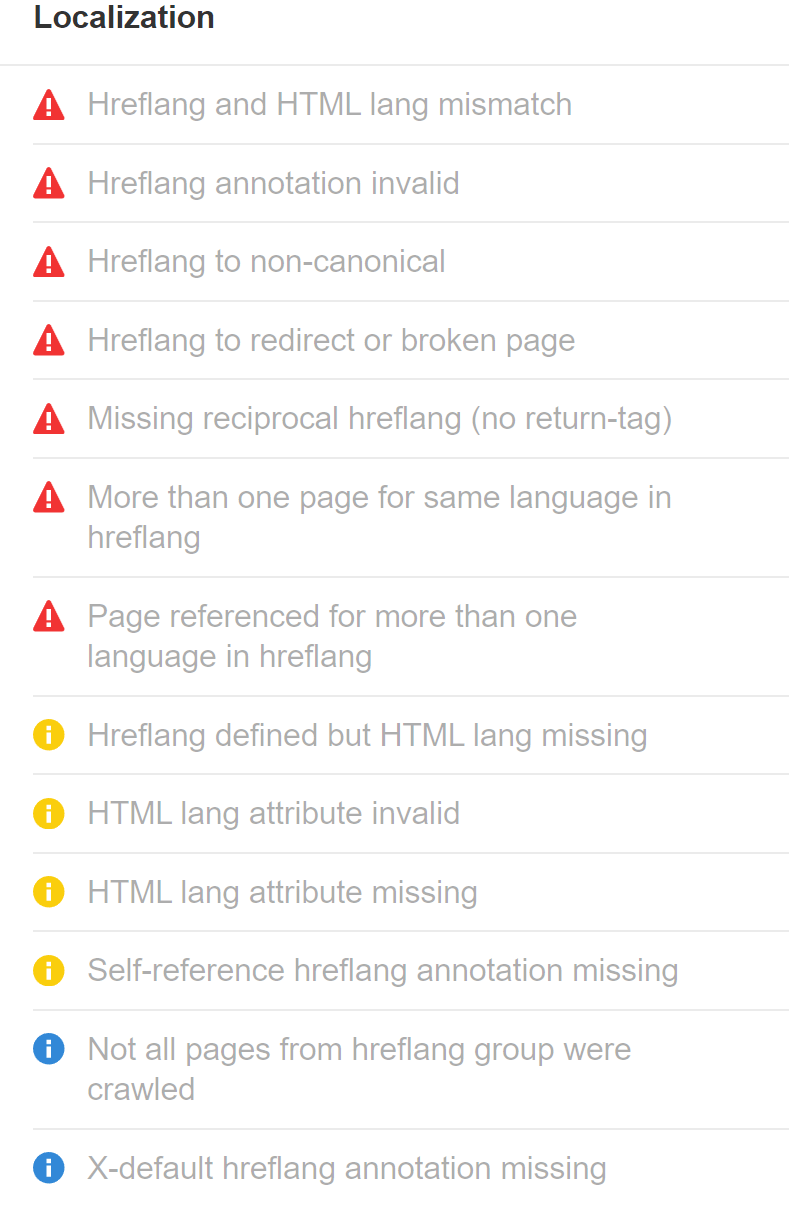
There are also some nice visualizations to help you explain issues like this first-if-its-kind hreflang cluster visualization. It shows and tells you what is broken, making it much easier to explain to stakeholders than the typical spreadsheet.
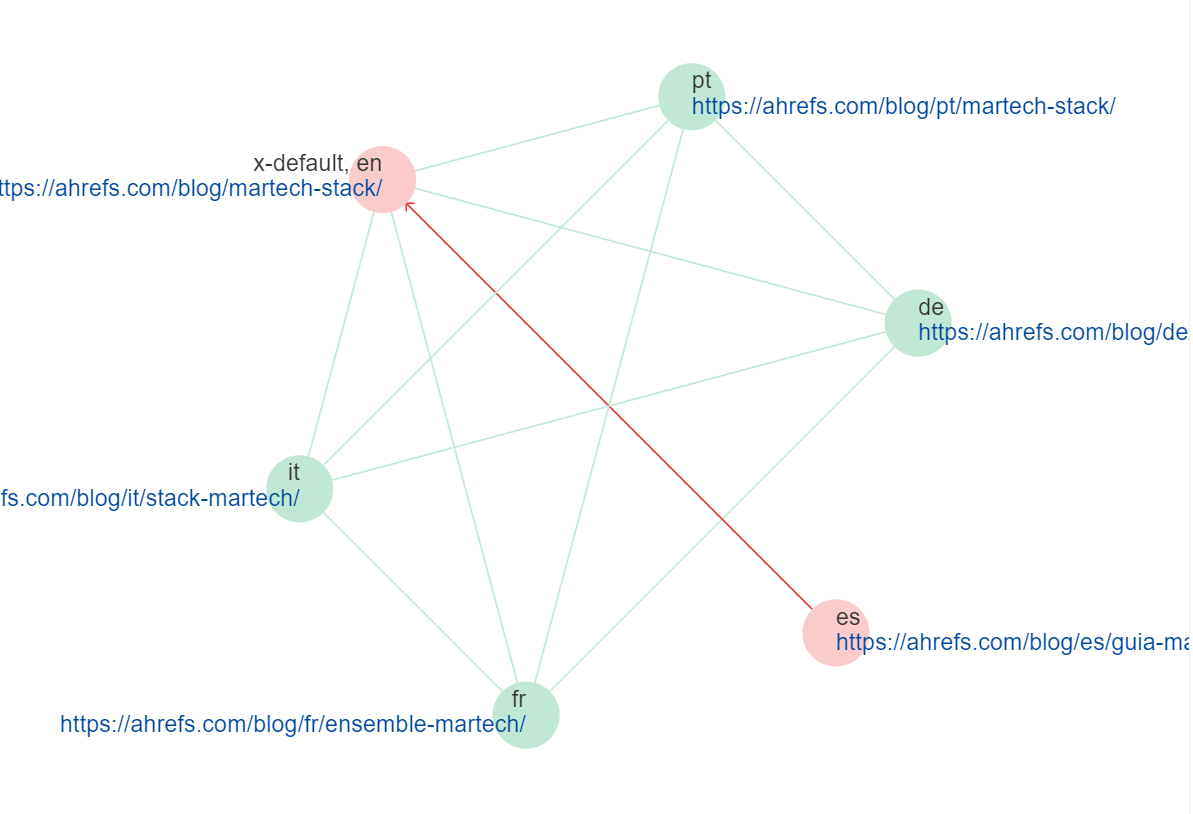
Optimize crawl budget
Priority depends on the site
Crawl budget can be a concern for larger sites with millions of pages or sites that are frequently updated. In general, if you have lots of pages not being crawled or updated as often as you’d like, then you may want to look into speeding up crawling.
Optimize ecommerce pages
Specialized task
Ecommerce SEO would be important for any sites selling products.
For enterprise sites, faceted navigation in particular can be tricky. Luckily we have a great guide on faceted navigation.
Fix JavaScript SEO issues
Specialized task
The bigger the site, the more likely you are to run into multiple tech stacks. Some of those may be JavaScript frameworks. These are relatively newer than CMSs and less understood by SEOs, so we have a guide on JavaScript SEO that covers many of the issues you’ll face and how to troubleshoot them, as well as how the rendering process works for Google.
Migrate other websites
Specialized task
A website migration is any significant change to a website’s domain, URLs, hosting, platform, or design. Big companies like to change these things and it creates havoc. Try to write any standards to keep things consistent and minimize the impact of changes.
Keep traffic during mergers and acquisitions
Specialized task
Enterprise companies buy other companies all the time. When I worked in enterprise SEO, I felt like I was constantly doing one website merger project or another. There’s a lot that can go wrong and a lot of money on the line. Check out our guide on SEO for mergers and acquisitions for more info.
Analyze log files
Specialized task
I would typically consider this task firmly in the developer department, but it is something that technical SEOs may be asked to do at times. Logs can be expensive to store and analyze and they contain private information (PII) with IP addresses, so many companies won’t give SEOs log file access. You may be able to get access for just major search bots like Googlebot and Bingbot if you ask.
The most common use case of logs is for seeing what pages to redirect, and you can usually get this from your analytics or the Crawl Stats report in Google Search Console.
I’ll be honest, I don’t see much value in log file analysis for technical SEOs. Finding and linking to orphaned pages which no one bothered to link to, or trying to get more low-value pages indexed that no one put effort into making better does not excite me.
I usually need them to troubleshoot an issue every couple of years or so. You might be able to make a case of getting logs for things like crawl budget or monitoring spikes in crawling which could indicate major changes on the site. In my experience, the effort and cost of log file analysis often exceeds the benefits.
Pull data from APIs
Specialized task
I wouldn’t expect every technical SEO to do this, and I usually consider working with APIs a job for a developer, but many technical SEOs do have the skills to help with this kind of thing. Typical use cases are data storage, report building, etc.
Machine learning tasks
Specialized task
This definitely isn’t a requirement for technical SEOs, but there are many who take on machine learning projects and help with things like semantic analysis, redirect automation, keyword clustering, etc.
Enterprise Local SEO refers to the process of optimizing a large-scale business’s online presence to improve its visibility in local search results across multiple geographic locations. It is particularly relevant for businesses with numerous branches, franchises, or service areas. The primary goal is to ensure that each location ranks well in local searches, thereby driving traffic and increasing conversions at the local level.
- 30% of all mobile searches are related to location.
- 78% of people who search for something nearby on their phones visit the business within a day.
- 28% of searches for something nearby result in a purchase.
On top of all the normal enterprise SEO challenges, with enterprise local SEO you also have to worry about bulk verification and management of Google Business Profile (GBP) listings. You may want to focus on improving the performance of important locations and underperforming locations.
Our guide on franchise SEO covers most of what you’d what to know for enterprise local SEO. Also check out our blog on location pages to see how we recommend you structure these pages.
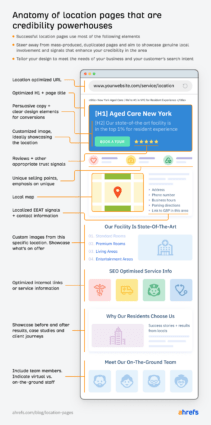
It works like this:
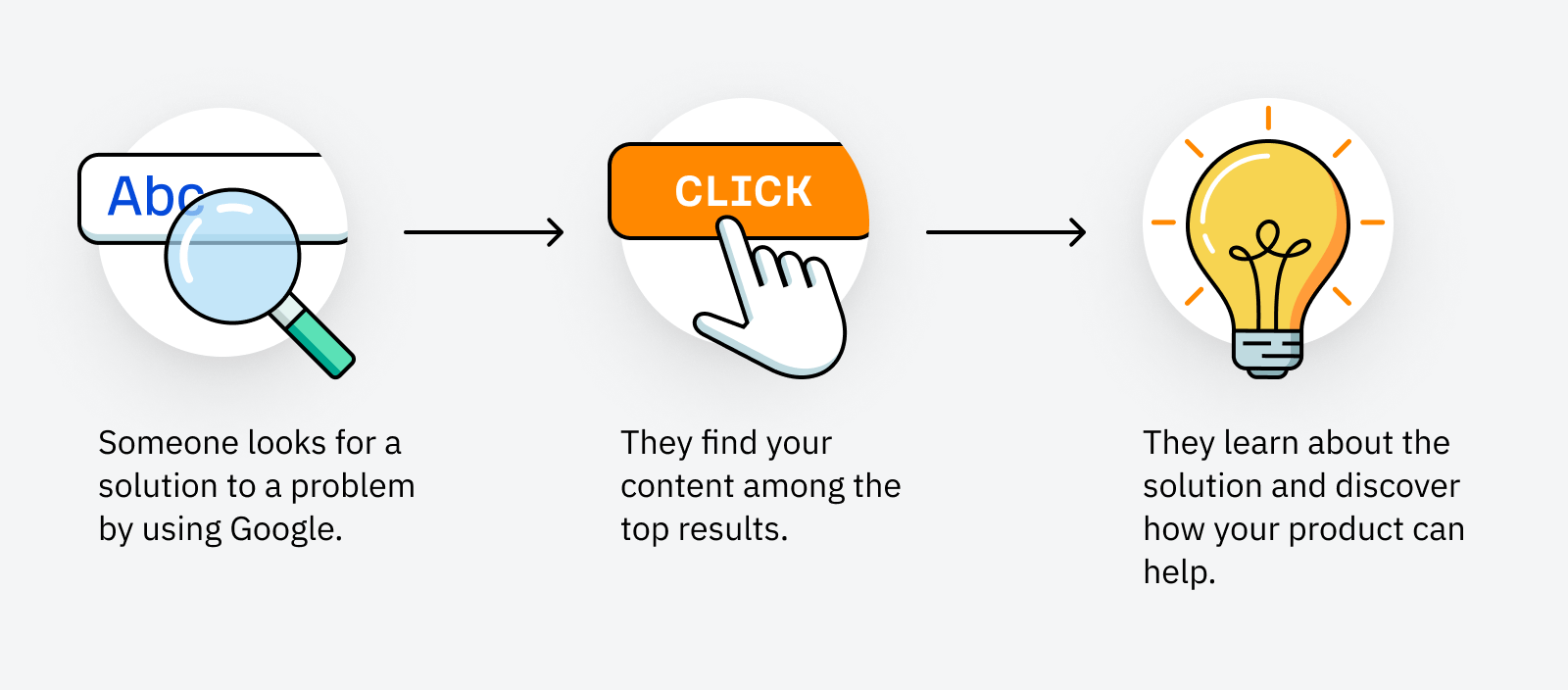
We have an entire guide on enterprise SaaS SEO that includes information on:
- Benefits of SEO for SaaS companies
- SEO challenges for Enterprise SaaS companies
- SaaS SEO examples
- Enterprise content marketing
- Enterprise link building
- Enterprise technical SEO
- Enterprise SEO reporting
- Enterprise SaaS SEO tools
Enterprise Ecommerce SEO refers to the process of optimizing large-scale ecommerce websites to improve their visibility in search engine results pages (SERPs). This type of SEO is tailored to enterprises with extensive product catalogs, complex site structures, and significant competition in their industries. The goal is to attract organic traffic, increase rankings, and drive conversions on a large scale.
Ecommerce sites have replaced affiliated for many queries containing “best”, “vs”, “guides” and more. You have opportunities beyond just your Product Description Pages (PDPs) and Product Listing Pages (PLPs) to capture organic search traffic.
Enterprise ecommerce technical SEO
Technical SEO can be complex and important for these kinds of sites. You’re working at a scale where little changes can have a big impact. I can’t cover everything in just this section, but I’d recommend you check out some of our technical SEO guides, especially those on:
- Hreflang (if international)
Product Description Pages (PDPs)
For PDPs, using the manufacturer description is fine. Rewriting it is often a huge time sink, and you could use that time to add value in other ways such as doing product reviews in text or video or adding your own info, product comparisons, additional useful features, etc.
Get creative. You don’t have to use a rating system that’s 1-5. What if you broke down important attributes of the product and had people rate each attribute? For example, for a laptop the things that are important to people might be screen brightness, battery life, weight, speed, etc.
Here’s an example of what an optimized PDP might look like.

Product Listing Pages (PLPs) / Category Pages
Depending on the type of company you are, you may not be able to rank as well as other websites can. If I’m searching for laptops, Apple probably won’t rank because their brand guidelines likely make them say MacBook instead of laptop. Other companies may not rank because they have 1 type of laptop, whereas folks like BestBuy sell laptops from many brands.
Your product selection matters and you want your listing page to have important products across various facets that users may want. Ecommerce sites order their listings in various ways like price, popularity, or various algorithms. I usually prefer showing top results from important facets over a big list.
This is what makes a page a good answer, not stuffing a bunch of content on the page. If you have content you want to add that is useful to users, that’s fine to include at the top or even small snippets for various sections, but hiding a bunch of content at the bottom is not something I would recommend. Here’s an example mockup.

Whether you are working in-house at an enterprise company or you’re an agency working with enterprise clients, navigating the corporate landscape can be complex. You may know exactly what your company needs to do to be successful, but getting it implemented can be a challenge. Here’s what you need to know to be successful in enterprise SEO.
- Getting buy-in for SEO
- Enterprise resources and planning
- Data/reporting
- Organization
- Training & evangelism
Getting buy-in for SEO
If the company you’re working with doesn’t see the value of SEO, you’ll lose resources and prioritization to whatever the company considers more important. That’s why it’s crucial to “sell” the importance of search. The easiest way is to prove value and equate everything back to revenue, or at least as close as you can get to revenue.
Using simple SEO facts in your presentations and messaging can help you sell the value of SEO to an enterprise. Here are a few examples:
- There are [x] monthly searches for [y]. Most people don’t realize that SEOs have data about what people search for. Simply telling people how many searches an important term gets will create some serious FOMO.
- 90.63% of pages get no organic search traffic from Google. (Ahrefs). Some people think that SEO isn’t necessary and that they’ll rank either way. This proves that isn’t the case.
- The average top-ranking page also ranks in the top 10 search results for nearly 1,000 other relevant keywords. (Ahrefs). This can help sell the idea that content should cover a topic in-depth and shows that pages rank for more than one keyword.
Beyond these, I also like to include some stats for the company. Metrics like the percentage of traffic from organic search, number of conversions, revenue, or Year over Year (YoY) growth all help to show how SEO is important to the organization. It’s also useful to remind folks that SEO is a continuous process since many people view it as a one-off task.
Bottom line: you need sticky messaging if you want people to remember you and care about SEO. Repeat what you said as many times as it takes.
Enterprise resources and planning
Resources are never unlimited. That’s true whether you’re part of an enterprise team or are an agency working with an enterprise company. There will be big budgets, but there’s also a ton to do, and enterprise SEO teams are likely to be pretty strapped for resources overall.
It’s going to take longer to get things done, and you’re unlikely to be chasing the latest SEO fad. For the most part, if you get the SEO basics right at the enterprise level, you’ll be doing better than most. Boring = $$$ when it comes to enterprise SEO.
You’ll have to do a lot more planning for resources and projects. You’ll have yearly planning or maybe even quarterly planning to align with company goals. Show them how SEO helps achieve company goals, and you’ll have more success. You’ll probably have to make SEO forecasts for where you’ll be a year from now and even forecast where you’ll be relative to competitors.
You’ll want a mix of enterprise SEO projects to be successful. Some may be company-wide initiatives or collaboration projects with other teams, while others may be specific to your team or even individuals.
You may have some enterprise SEO projects to focus on top pages, individual sections of the site, top products by sales, or any number of other things. Part of your job is to prioritize everything. However, you can’t focus on everything because if everything is important, nothing is.
You’re likely to see different prioritization methods that involve calculations such as Potential Importance Ease (PIE). I like to use an Impact Effort Matrix like the one below because it’s more visual. Anything high-impact and low-effort is a quick win, so tackle those tasks first.
Projects like reclaiming links to your website or adding internal links will likely fit this description. Content creation is usually always a long-term project. Less important things go into your backlog for when you have more time, and projects where you can’t justify the resources because they are high effort and low impact will probably never happen.
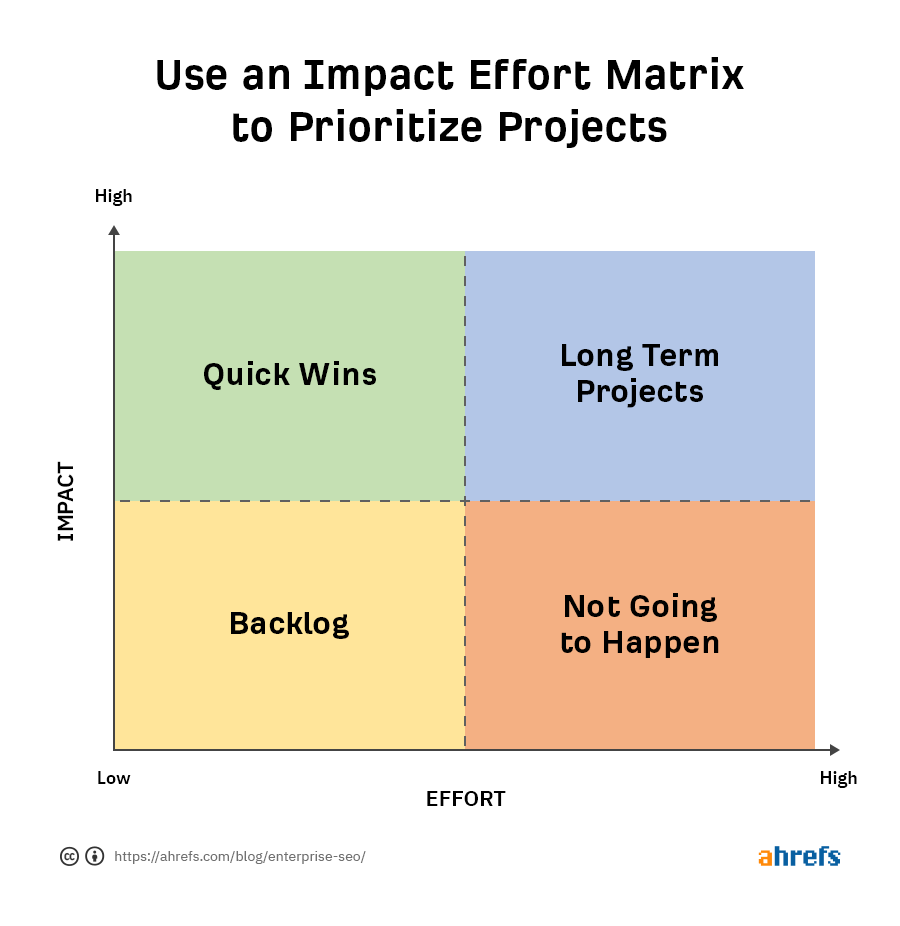
One of the mistakes many SEOs make in an enterprise environment is getting caught up in ‘busy work.’ Yes, the more things you’re involved in, the more things you can catch and influence. However, it’s easy to find yourself in a position where you’re just ticking off boxes and not strategizing. The result is micro gains while still having macro problems.
Enterprise is all about scale, and that includes how you work. You have to focus on what will have the most impact, which means that you really shouldn’t be involved in every task or process.
Data/reporting
Reporting can be a colossal time sink at the enterprise level, but it’s a necessary evil. If you can’t prove your work’s value and how it contributes to the company, nobody will see the importance of enterprise SEO.
Two ways I usually go about getting buy-in are to report on revenue or to compare vs competitors. Money talks, and no one wants to lose to their competition.
You’re probably going to have reports in PowerPoint, dashboards, and maybe even in internal tools. The main thing to remember is to adjust your report to include what your audience finds important. You may have SEO KPIs that are important to your team, but other teams will likely focus more on conversions and revenue.
It’s likely that the higher you go, the more people will want simply one number that tells them how things are going and if you can make that number revenue, you will be golden.
You will probably have to adjust reporting frequency too since some will want real-time reporting, and others may only want monthly, quarterly, or yearly reports.
Numbers can be memorable and help sell ideas in presentations, but you’ll want to focus more on visualizations that are easy to understand when reporting. The easier to understand these are, the more memorable they will be. For example, a quick pie chart showing branded vs. unbranded traffic is likely to show that most organic visitors come from branded terms, and you should be more focused on unbranded terms.
You’ll also want to do an overview with teams of different tools and data you have access to. You have to remember that they likely don’t know about the tools, metrics, or data you have, and you may not know what data they need to make decisions.
Meet with various stakeholders and find out what they need. Some of the things SEOs consider simple, like keyword data, can be extremely useful to other teams and help them make informed decisions. Share of Voice will be useful for executives and product teams to let them know their market position. Paid and product teams may want to see the distribution of Organic, Paid, and no-click searches like we show in Keywords Explorer.

One final tip for reporting is to use the success from initiatives with one group to promote and roll out company-wide. Tell the story of how you worked with the team, what went well, lessons learned, and how you think the process should change going forward.
Storytelling goes a long way in helping to drive adoption. You can also win brownie points by making others the hero; write them good feedback and peer reviews, and they’ll be more likely to work well with you in the future.
Check out our guide on enterprise SEO metrics, reporting, and dashboards to see the types of reports you might want to create.
Organization
Enterprise organizations tend to be complicated. You’ll likely have many chains of management and a lot of complexity to learn before you can make progress on some projects. Just finding your way around to the right teams and the right people can take time, and external teams may have to rely on the internal team for a lot of this knowledge.
Enterprise SEO team organization
Enterprise SEO teams can and do sit in many different organizations—marketing, Analytics, Product, Development, Content, Digital, etc. I don’t think there’s any right or wrong answer to where SEOs should be, and a lot depends on the company organization itself.
No matter where you sit, you will probably work with all these teams and more. Where your team sits may even change over time as companies reorganize or merge with other companies. You’re likely to break into different specialties like content, links, or technical SEO. You also may just have representatives that coordinate with other teams or business units.
Other teams
For every task that an SEO agency may be responsible for, there’s likely to be a team doing that at the enterprise level. You’ll probably run into teams you’ve never heard of like taxonomy/ontology, and work with teams you wouldn’t have thought of like events, branding, or legal. In many cases, you’ll be working with these teams on various projects, or to get permissions you may need to be successful.
You’ll want to have as much visibility into what’s being worked on at the company as possible and make sure these teams know you exist and loop you in when needed. You’ll find that many of these teams have weekly meetings, office hours, networking events, and even ‘lunch and learns.’
All of these are great ways to learn who does what and what they’re working on. You should probably have all of these things for your enterprise SEO team as well. Donuts, pizza, and beer will help you meet people, but the educational components and sharing of information will help you be memorable.
I was always opportunistic in my SEO approach and tried to work with teams when they were ready to go on projects. Miss this chance, and it might be a while before they’re willing to work with the SEO team again.
External SEO agencies
You’re likely to have an agency for additional SEO services or possibly multiple agencies for different needs. It’s often easier to get these additional agency services than it is to get another full-time employee because of the way budgets typically work.
The way I’ve seen this work best is to have agencies fill in the gaps from your team. Maybe that’s doing more grunt work, specific tasks your team might not have much experience with, or just providing additional resources to enable your team to do more.
They’re also useful as a second set of eyes for identifying problems, opportunities, and providing solutions. You may want your agency partner to do an enterprise SEO audit and present the results. This will often include the same things you and your team have been saying, but coming from an outside service agency it reinforces what you’ve been saying and you’re more likely to get buy-in from leadership.
If you are an enterprise SEO agency, my best piece of advice is to be flexible and do whatever the in-house SEO team needs you to do at the time. Your job is to make the in-house person or team look good, get them promoted, and get them more resources.
If you’re shopping for agency services, ask around for who others recommend. There are some great enterprise SEO agencies. Many in-house SEOs tend to avoid the SEO services packaged with the tool providers. These are often expensive for the quality of the provided services, but occasionally you might have a good consultant on your account that stays for a while.
Ahrefs provides some services, but they’re more focused on the tool and onboarding, not professional services. Our services include:
- Dedicated Ahrefs account manager
- Tailored onboarding
- 24/7 multilingual chat support
- Access to monthly webinars and workshops
- Access to our expert SEO team in our Ahrefs community
If you’re looking for an enterprise SEO agency, check out our SEO agencies directory. When we did a survey on SEO pricing, it seemed that many consulting services for enterprises started at around $5,000 a month, but could sometimes be $50,000 a month or more.
SEO training & evangelism
The more you share with and empower others, the easier your life will be at an enterprise company. Remember, you have resource constraints, so train people and find your evangelists who believe in and help promote SEO in you enterprise organization. It’ll help you scale your impact.
All of the things I mentioned earlier, like weekly meetings, office hours, networking events, and ‘lunch and learns’ are great for training and evangelism. But you can also do individual team trainings, group trainings, workshops, and internal courses that focus on different topics or tools.
Look for opportunities to add an SEO session to company events/workshops/training other teams may be hosting. There are likely to be events targeted towards marketing, development, analytics or any number of opportunities where SEO can be a relevant topic. Maybe even start an email newsletter with company and SEO industry updates people would find useful. Any chance to show your expertise will help your enterprise SEO program be successful.
Some popular enterprise SEO tools include:
| Product | Reviews | Pricing | Customers |
|---|---|---|---|
| Ahrefs | Starts at $14,990 / year | 60,000+ | |
| Conductor |
| No public pricing | 450+ |
| seoClarity | 3,500+ | ||
| Botify |
| No public pricing | 500+ |
| BrightEdge | No public pricing | 1,700+ |
With so many different tools and so many different needs, how do you know what’s right for you?
I’m obviously biased towards Ahrefs, but we’re really in a league of our own with 44% of the S&P 500 choosing us. Look how we compare to other enterprise SEO tools in the market.

And our organic search share of voice (SoV).

Determining how much you should invest in enterprise SEO can be complicated. Here’s an ROI calculator that can help you with ballpark estimates.
If you want to try a more advanced option, check out our free enterprise SEO ROI calculator.
Final thoughts
There’s so much at stake in enterprise SEO and so many opportunities. Don’t get discouraged if you’re not making progress. Just try another way and never give up, and eventually you’ll make progress. When a company and its people finally get behind SEO, they can dominate an industry.
In this article, I wanted to communicate some of my experience in the enterprise world, and some things that I thought would be helpful. I hope it’s valuable information to some of you that are reading.
If you have any tips, enterprise SEO experiences you’d like to share or questions, let me know on Twitter.



